The Name Of A Rose
Monday, April 30, 2007
Roses are beautiful, they are fragrant (the ones in my garden are), they have elaborate and an interesting history and, best of all, they have names that conjure all kinds of romantic images.
It escapes me that Shropshire rose breeder, David Austin would name one of the best of his really red roses(and the redest in my garden)after his father-in-law, Leonard Braithwaite. How much romance can there be in the name Rosa 'L.D. Braithwaite'?
The Belgians and the Frenchmen of the 19th century knew how to name their roses. In a man's world some of the roses were named after men's wives without ever giving a hint as to their real names. As an example one of the most delicate of my Bourbon Roses, a sport of Rosa 'Reine Victoria', is Rosa 'Mme Pierre Ogier', below.
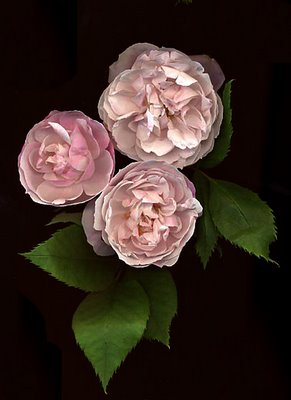
It has the same delightfull shape of a ping-pong ball but instead of being deep pink it is a delicate shade of white with pink overtones. Who was Pierre Oger? We don't know. French hybridizer Margottin named his best Bourbon 'Louise Odier', below, in 1851.
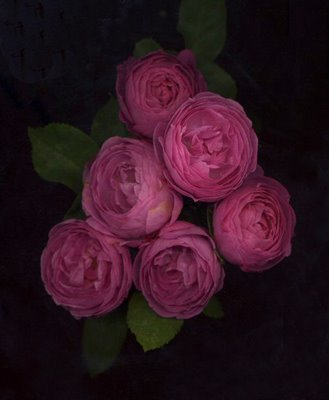
We don't know who she is. I have often been tempted to buy Rosa 'Mme Isaac Pereire', also a Bourbon bred by Garcon in 1881. This rose has the reputation of having the most fragrance of any rose. What is interesting is that we do know who Mme Isaac Pereire is. She was the wife of a Parisian banker. His name suggests that he was perhaps a Jew with Sephardic roots. His wife may have been (in my imagination) a woman similar in looks to Shakespeare's Dark Lady. I may go back to Free Spirit Nursery in Langley as he has a couple of Mme Isaac Pereires. I could have bought her yesterday when I visited Lambert's Free Spirit but I fell for another name, a rose called Rosa 'Ghislaine de Féligonde'. French breeder Turbat named this rose in 1916 after a now unknown Flemish woman. That first name is pronounced Elaine.
Tune in here in June as I will post a scan of this small climber with orange-yellow flowers that grow in large clusters.
Rosa 'Agnes' , John Tuytle & The VanDusen Plant Sale
Sunday, April 29, 2007

This entry is a sad one for me. For 18 years I attended (bright and early around 7am) the once a year VanDusen Botanical Garden Plant Sale held today. As I write I this morning I am not on that line. I am sure that it would not have taken me much effort to find a few gems for my garden at the sale in spite of the trend (a decline of sorts) in local plant sales. Fewer and fewer older gardeners are around to divide their plants and donate them to plant sales. There are fewer instances of gardeners at VanDusen dividing plants from that garden. So more and more of these plant sales are simply no different from going to local nurseries. In fact many of the plants in today's VanDusen sale will be plants purchased from those nurseries. The chances of finding those hard-to-find specimens are slim. In years past I found rare hydrangeas and dwarf conifers.
Best of all it was at VanDusen where my interest in buying and collecting fragrant or otherwise interesting roses began. It began because of the pleasant volunteers from the Vancouver Rose Society who would be there to recommend and enthuse me. Christine Allen, who propagated old roses decamped to Australia last year and this year my Dutch/Canadian friend, John Tuytle (83) has decided not to attend and he scrapped his old and rare rose "business" last year because of heart problems.
Johne Tuytle has a sheep farm in Langley but he no longer has lambs. "To much trouble," he told me last week. In this farm any gardener would go nuts as I have the times I have been there. Not only does John have the best and rarest roses in his gardens he has a special green thumb for eryngiums. The largest I have ever seen I saw there and the bluest of blue specimens were in his garden. John is also a carpenter/artist and his gates, fences, bird houses are a delight.
Every year at the VanDusen sale I would run over to the roses to ask John what he had brought and he would proudly point to this one and that one. One year I remember I was looking for an extrememly rare plant that was one of the parents of David Austin's first English Rose, the myrrh fragranced Rosa 'Constance Spry'. "Do you have Belle Isis?" I asked John. I pronounced the latter part of the name to rhyme with crisis. With a twinkle behind his glasses (John twinkles a lot) he said, "I don't know about that rose but here I have Rosa 'Belle Isis'," and he pronounced it in the correct French.
John's interest in propagating hard-to-find roses was never really a business as he only brought his roses to the VanDusen sale and a few others found themselves at Christine Allen's little Langley Rose nursery (now sadly closed).
My relationship and friendship with John began in late July, 2000. It was then that Canada Post comissioned me to find and photograph 6 Canadian roses that would then be paired down to four that would ultimately become stamps in August, 2001. As things go with requests of a botanical nature by those who have no idea of when plants bloom I knew I was in trouble, Most roses flower in late May and June and by July they either stop blooming or they do so sporadically.
Only John had the rare (for BC as it does not grow well in our rains) 1922 Rosa ' Agnes'. This rose, a relative of the extremely hardy Japanese rugosas, was the first ever yellow rugosa. It was perhaps the first famous Canadian rose. For weeks I called John to ask him how his Agnes was doing. It wasn't! Then one day in the beginning of a very hot day in August he called, "Come now, she is in bloom. There are two flowers." Like a shot I drove to Langley only to find a couple of flowers that that were beginning to wane in the heat. Somehow I managed. I feel, to this day that Rosa 'Agnes' cemented a bond between the kindly Dutch man and me. I don't quite believe John when he told me a few years later, "She was a terrible rose, I burned her."
As property becomes more expensive in our area younger people are buying condominiums and the need for a garden is curtailed. Nurseries are going through a terrible stage trying to find ways of enticing old timers like me to return while at the same time "training" the young crowd to develop a passion for plants and gardens.
I am sure that it will all change for the better soon. But why would anybody want to buy a painting or a photograph to put in the living room when a large plasma TV can replace and be much more "interactive"? Gardening is hard work. It is far better to stay inside and watch vicariously someone talk about someone else's garden. It seems that both the photography/art and nursery business is going through an unexpected transition.
Until things change I can only treasure John's roses in my garden.
This is a sad entry because I cannot post a picture of John. I never got around to it. John has invited Rebecca and me to visit him in the fall. I will make sure I take his portrait.
Men Dancing
Saturday, April 28, 2007
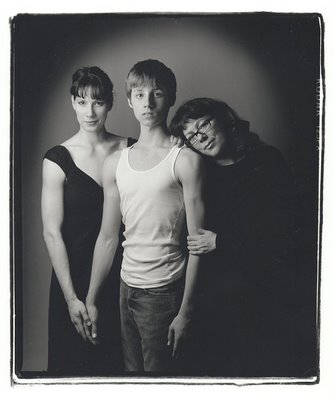
Last night Rebecca and I attended the Arts Umbrella Dance Company Season Finale at the Vancouver Playhouse Theatre. Because most people don't seem to know we were able to sit front row middle which is how we like it. From there we could notice all the details and hear the dancer's breathing. Hearing them breathe is part of the thrill of dance.
Both Rebecca and I know most of the dancers (we have observed them for the last four years) of the Senior Company and the Apprentice (sort of like the grade 11s). We both agreed and really liked Emily Molnar's (seen in top photo with dancer Alex Burton and Arts Umbrella's Dancer Director Arty Gordon) Opus featuring the Senior Dance Company and the music of Philip Glass. It was amazing to watch the dancers leap back and forth, specially Connor Gnam seen in the middle photo with Boys Only and Ballet BC dancer Edmond Kilpatrick giving him a noogie).
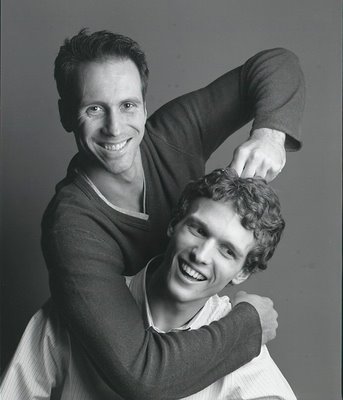
But we both agreed that we liked best the performances of the Apprentices because in all but one dance number it featured the five boys (how could the one Connor in the Seniors compete wiuth the five fabulous boys?). The boys are seen here with the flexible and graceful Nina Davies clockwise, Michel Issa Rubio, Jeremiah Kennedy, Jed Difhuis and Scott Fowler.
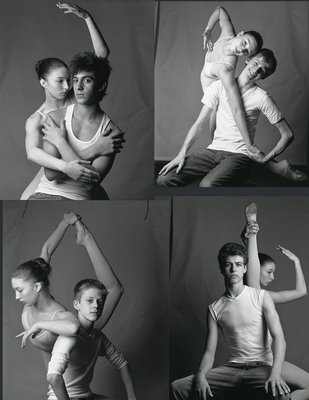
But Rebecca and I disagreed on which boys' number we liked best. Rebecca (would she be more romantic than her grandfather?) liked the ballroom dancing parts of Ballet BC's strangely named Lhaugs and Glieggs (with music by Gershwin) while I liked (loved) Roberto Campanella's (ProArteDanza, Toronto) Unforseen which featured the Apprentices with the five boys and a stellar performance by Alex Burton and Nina Davies.
Who would have ever guessed that this old man, with so many beautiful girls dancing, would ever see a performance through the eyes of a little girl? Those boys were really good! And through it all I could see why Rebecca has a fondness for Scott Fowler. He was a dazzling Puck-like performer who at 13 could fit into a professional dance company and still be noticed.
Mstislav Rostropovich - Slava- Glory No More
Friday, April 27, 2007
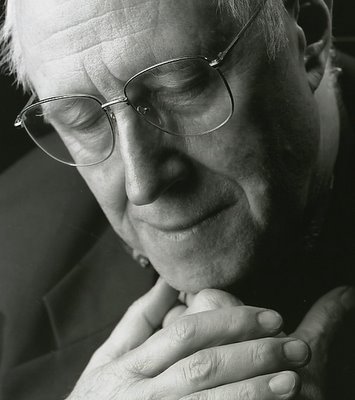
Mstislav Rostropovich died today. His nickname, Slava means glory.
To this day I can remember being kissed by my father. I can even conjure his smell. It was a combination of a long forgotten aftershave of the 50s, the Player's Navy Cut tobacco he smoked and the Old Smuggler's whisky he drank. I don't allow too many men to kiss me or do I kiss them. But here are two men who caught me off guard. One twice and the other four times. And I will never forget.
When I photographed Russian poet Yevgeny Yevtushenko (below) we found out we shared a language. I spoke my Argentine Spanish and he a fluent Cuban. We hit it off and he liked his pictures so much he kissed me, Russian style on each cheek in combination with a bear hug that almost collapsed my rib cage.
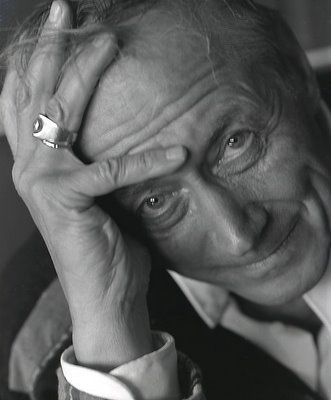
But it was Mstislav Rostropovich, above, left (called the Human Cello by Yevtushenko in his novel Don't Die Before You're Dead) who really surprised me. After a concert at the Orpheum I went to his dressing room to give him some of the photos I had taken of him. In the presence of many people he called me, "Maestro," and then proceded to kiss me twice and then again!
From "Goodbye Our Red Flag"
.. . . I didn't take the Tsar's Winter Palace.
I didn't storm Hitler's Reichstag.
I am not what you call a "Commie."
But I caress the Red Flag
and cry.
Yevgeny Yevtushenko
Yevtushenko
Adrian du Plessis - Investigator
Thursday, April 26, 2007
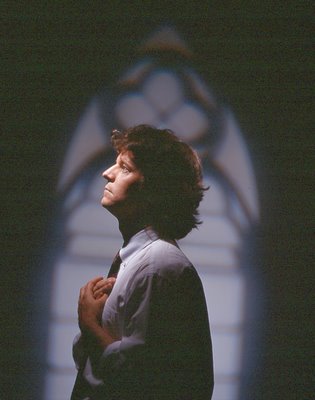
Adrian why hast thou forsaken us?
Some 28 years ago at a Vancouver punk concert (of all places, Carnegie Centre on Main and Hastings) I met a nerdy young man (with glasses, natch) who said he was the manager of one of the bands playing that evening. His band were The Metros and his name was Adrian du Plessis. With him was a woman almost 6 ft tall in black, wearing chains and leather. She was gorgeous. "And this is my girlfriend," he said to me.
From rock 'n roll he switched to what he always called white collar crime. Behind the scenes he investigated our then notorious stock exchange. Many believe he almost made it go down in flames. Then he became less behind the scenes and started writing articles for magazines where the editors had to consult in detail with lawyers to avoid lawsuits. As far as I know du Plessis only wrote the truth and it was always a truth he had painstakingly researched over a long period of time.
I made it a habit to call him up before I had to photograph a businessman for a magazine or the Globe & Mail or the Financial Post. While I never revealed to my subjects what I knew about them it helped me in being objective with my photography. I enclose here the first page of a long article du Plessis sent me a week before I photographed Robert Friedland.
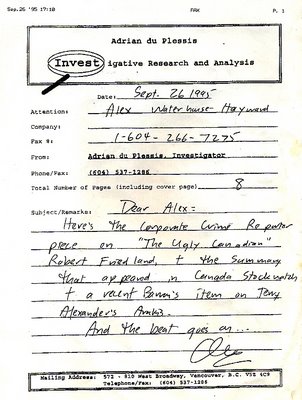
Whenever I ran into him (he cycled everywhere) we always chatted and I never failed to mention that I found it incredible he had not been bumped off or that I had yet to read a Vancouver Sun headline that du Plessis had been found floating face down in Burrard Inlet.
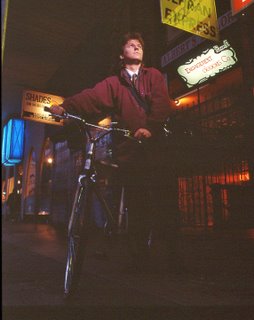
Part of du Plessis' talent came from an incredible photographic memory. A man's photo would appear on the front page of the Sun with an article on how he had been caught red-handed in a bank scandal. Five years later (the limit of Vancouver's long time memory for facts such as these) the same man would be on the business page promoting a Veracruz sunken gold venture. Only du Plessis remembered.
But there is another man whose memory may be as good, and like du Plessis it would be next to impossible to buy. This is the Vancouver Sun's investigative business reporter, David Baines (below). For many years in those terrible times of our notorious stock exchange (the 80s and early 90s) Baines wrote damning articles on the shenanigans that passed for routine business in our city. Many of those articles were fueled by du Plessis' research. And I distinctly remember that several times security was provided for Baines as he did receive death threats.
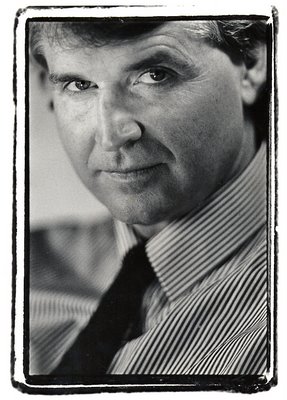
As far as I know du Plessis never bought a car and never made much money with his writing. He now lives on Saltspring Island and manages Allison Crowe.
I believe that had the December 28, 2003 BC Legislature raid in Victoria been investigated by a du Plessis/Baines team (someone would have gently pushed them from business to politics) we would not be where we are now. I only wonder how du Plessis would modify his often used term white collar crime for incidents such as these.
----------------------------------------------------------------
Addendum
The bicycle pictured in the second shot on your blog
page of today was stolen when, exhausted from all
night investigative work, I failed to lock it up outside
my Commercial Drive apartment one morning. It
was a good ride.
What I'm doing these days is pretty much the same
search for truth, in different form. Like Art
Bergmann, like Johnny Thunders, Allison makes
music from the heart. In today's music scene that's
as rare a flower as one can find.
Wishing you and your loved ones the best of this
season, and all to be. Thank you.
Sláinte mhaith, Adrian
David Radler -John Cruickshank & Brian Evans Sing O Canada
Wednesday, April 25, 2007
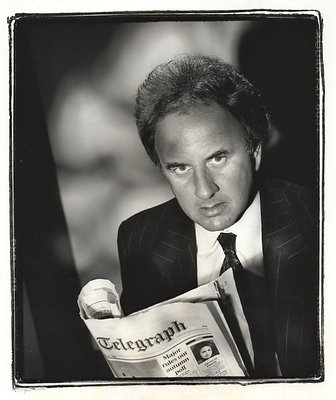
I have never understood dishonesty. It was my grandmother who used to tell me, "Piensa mal y acertarás." (Think the worst and you will be right.) She was very Catholic and was a firm believer in the concept of original sin and how we humans had a propensity for evil. Only grace through the Catholic Sacraments could save us from ourselves. I chose to disagree with her (not openly) and I always expected the best of people. When they did wrong it was always a surprise to me but I tried not to let it bother me.
While in the Argentine Navy I understood the corrupting influence of power and ambition. We used to joke that the next promotion for a four-star general or admiral President. Most of the ills of my country came about because of power and ambition.
I was once robbed in a Mexican bus and I was powerless because I had my two-year-old daughter in my arm. It happened a few days before Christmas. While delivering our Christmas presents on another year someone broke into our VW and stole the presents that had yet to be delivered. But somehow Rosemary and I never remained bitter for long.
The first and last time that I was ever treated somewhat hdishonestly by anybody was recently in 1997. I had photographed Sinatraish crooner Brian Evans (Michael Bublé was mostly unknown then) for Vancouver Magazine.
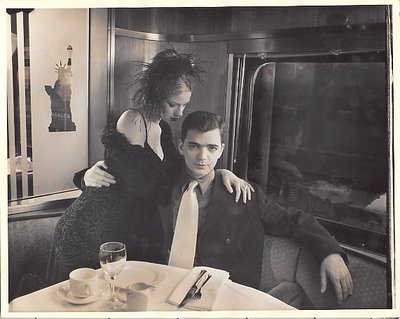
I had picked the New York rail car of BC Rail as a location and Ann Murray, the lovely daughter of a friend of mine had been thrilled to pose with Evans. As he posed for me Evans kept singing O Canada. He was to sing our anthem that evening at a BC Lions Game. I was charmed my his romantic patriotism even though he had been born in Massachusetts. A few weeks later he asked me if he could use the picture for his CD cover. We arrived at a fee and I billed him. I was never paid.
All this brings me to my photographic relationship with David Radler. I first photographed him for an early 80s article by Valerie Gibson for Vancouver Magazine about all the up and coming powerful people of Vancouver.
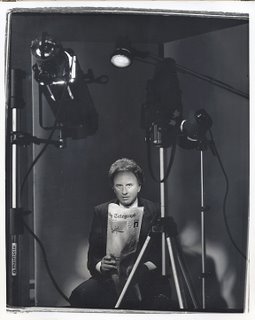
I photographed him for magazines three more times and then Radler hired me to take pictures for an annual report. My dealings with him were always pleasant and cordial. We once spoke about Malcolm Parry. Of Parry he told me, "I really like his gossip column and if it were up to me I would make him write it every day." He was obviously a fan. We chatted about other things but when I would ask about his family he always told me that he guarded their privacy and would never allow a photographer in his home. Radler was extremely proud of his Cadillac. He asked me to photograph him with it for one of the shots for his annual report.
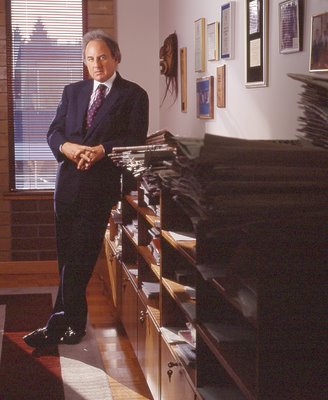
The colour photograph of him standing in his office I took in 1994 for an article that John Lekich wrote for the waning business magazine Equity. I was present for the interview and it was funny how Lekich and Radler talked about their love for baseball.
Radler was a man who loved baseball and as boy had a paper route. That did not prepare me for what is currently happening with Radler and Lord Black. He has bargained with the prosecution and will serve less time in jail.
I never saw this in the man I photographed so many times. He even posed for me in the b+w photos for Business in Vancouver which certainly don't show him in the best light. Perhaps I never gave it a thought that they reveal him as a very powerful man and that once you have a few million dollars only power can make more money any sweeter.
In 1995 John Cruickshank became Editor-in-Chief of the Vancouver Sun. I immediately saw sweeping and positives changes in our city paper. Cruickshank hired David Beers who created in Mix the best Saturday Magazine the Vancouver Sun ever had.
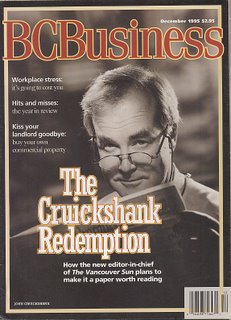
One day late in 1997 Cruickshank spotted me in the lobby and asked me to accompany him into his office. It was there that he revealed to me that he was going to have Beers "Mix" the rest of the paper and that he saw my photography as playing a part in it all. Soon after David Radler made one of the smartest decisions of his life in promoting Cruickshank and sending him to Chicago to the Sun Times where Cruickshank is now the publisher. Beers was left in an office with little to do and Mix soon lost its life force. I regret to this day Radler's smart move.
Susan Fiedler - A Face
Tuesday, April 24, 2007
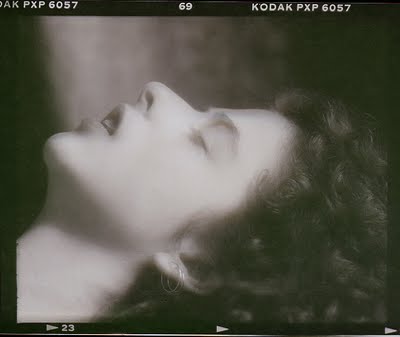
I am not quite sure when I photographed Susan Fiedler. I know I photographed her in my studio once and another time in Lynn Canyon. She designed jewelry.
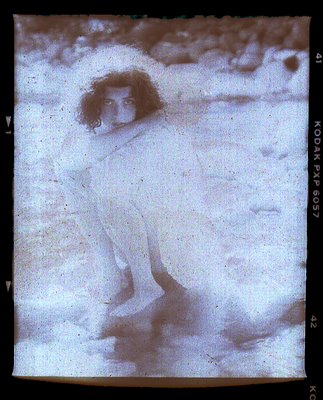
She had a face. She had a face that seemed to be from the 1920s or even from the previous century.
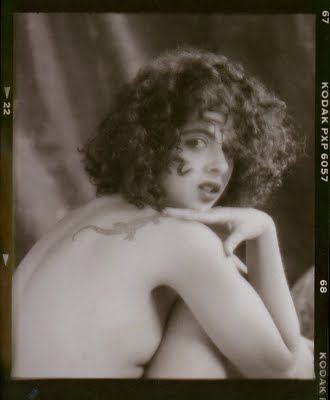
She didn't volunteer to smile for my pictures nor did I ever ask her to. She had a look of sadness and longing. It was a look of sensuality.
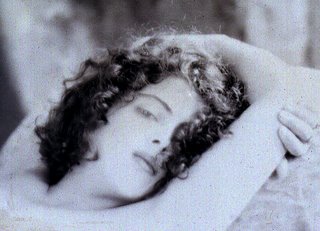
Lying on my studio psychiatric couch ( I purchased it for $100 from a retiring member of that profession) she posed languidly and at a certain moment she lowered the straps of her dress and said, "This is what you want, don't you?"
Yes, I did.
The Cecil Hotel, One Yugoslavian & 9 English Bobbies
Monday, April 23, 2007
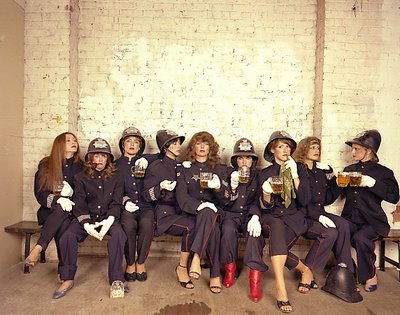
For oft, when on my couch I lie
In vacant or in pensive mood,
They flash upon that inward eye
Which is the bliss of solitude;
And then my heart with pleasure fills,
And dances with the daffodils.
William Wordsworth - I Wondered Lonely As a Cloud
The Cecil Hotel on Granville and Drake was an important location for my career as a magazine photographer in Vancouver. It was the spot of choice for long lunches for Vancouver Magazine editor Mac Parry who prononuced Cecil as sessle. It was here where Parry told me to go home and photograph my cat and make sure his whiskers were sharp. That issue of the magazine (March 82) featured an article on strippers by Les Wiseman. Wiseman and I, who at the time spent much too much time in strip parlours (he drinking beer and me dry pear cider), conned Parry into accepting an article on strippers by stressing its business angle. While we had photographs of our favourite dancers I also photographed the owners of the strip pubs. One of them was the melancholic Yugoslavian Sam Sorich who owned the Cecil Hotel. Of all the Vancouver bar owners Sorich was the one I liked best. He seemed to be honest and the dancers respected him.
A few years after the Vancouver Magazine article Sorich approached me with an idea. At the time the pub was decorated with a very large painted mural of 9 English Bobbies. I had not made the connection and perhaps the connection was only coincidental. Bobbies were also called Peelers after Sir Robert Peel who organized London's Metropolitan Police. Sorich wanted me to make a facsimile of the mural with 9 dancers dressed in Peeler uniforms. Unbelievable but true, Watt's Costumes had 9 complete unforms.
This task was a difficult one. The most trying part was getting 9 women who worked long evening shift to show up at the same place and at the same time. I chose as a shooting location a warehouse on Railway Street that had a painted white brick wall like the Cecil mural. My assistant wondered why I had set up a changing area with some large sheets that gave the dancers privacy. "They are strippers, aren't they?" Even I understood that every profession has its rules and code of ethics and that as human beings we all need privacy in context with the situation. The dancers were not working, they were posing for my camera.
And my camera was a rented Linhof 4x5 inch. Years before I had made up my mind that I never wanted to see the world upside down (as is the case with 4x5 bellows cameras) and that I would never use one. This occasion marked the first and last time I ever used one. I had to use it because the print that was put in the Cecil Hotel (I believe it still is there by the pool table) was huge.
I have kept track of some of my mural subjects and when we reminisce we always remember that onions were being stored in the warehouse and some were rotting. Except for that terrible smell we had fun and the world seemed to be less complicated.
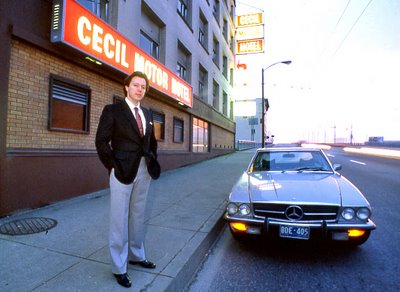
Could that sadness in Sam Sorich's face reflect that he knew it was the end of an era? The Cecil is much too loud now and the dancers are mechanical. Subtlety is long gone.
Rags, Flags & Citizenship
Sunday, April 22, 2007
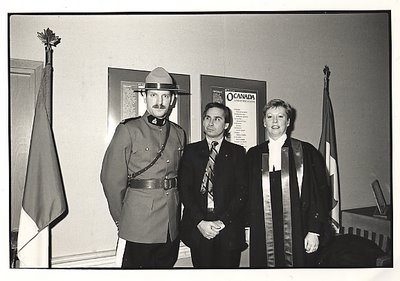
Last night I attended a celebration in which my photography student Rona Tattersdill (a fine English woman in all respects ) became a Canadian citizen. Many of the guests where dressed in red and white and the cake was a Canadian flag. The happy and fun celebration made me think of my own when some 15 years ago I showed up at citizenship court with my father's King James Bible. By contrast it was more somber and even efficient.
"¿Juráis a la Patria sequir constantemente su Bandera y defenderla hasta perder la vida? "
"Si Juramos!"
---------------------------------------------------------------------------------------------------------------------------------
One of the most emotional moments of my life happened on June 20, 1965 in Parque Almirante Guillermo Brown (William Brown) in Buenos Aires. I was one of thousands of smartly dressed sailors in white swearing allegiance to our flag (jura a la bandera). Our flag was raised and we sang our national anthem. Rear Admiral Ricardo Sanchez Sañudo asked us, "¿Jurais..... if we would follow our flag at all times and defend her even with our life. In unison we answered, "We do!"
One year and 8 days later contingents of the Argentine army, navy and air force surrounded (I was one of them) the "Casa Rosada" and we gave our legally elected president Arturo Illía 60 minutes to leave the premises. This he did in a cab. The next day the military junta headed by General Juan Carlos Onganía had banned all political parties, closed congress and banned our constitution. After that coup I began to believe that the difference between the Argentine flag I had sworn to defend and any other flag from any other country was simply a colour dye. In essence, the flag I had cried for was a meaningless rag.
Politics in my return to Mexico did not change my perception specially when the Díaz Ordaz government brutally repressed a student uprising in Tlatelolco, prior to the the 1968 olympics in Mexico.
But for years I clung to the concept of traveling with my blue leather Argentine passport even when the paper work to get one in Canada became very difficult. Upon my return to Buenos Aires around 1985 my consular passport was cancelled (by law) and I would have spent most of my two week stay in Buenos Aires lining up at the police station getting a new one. Through my half-brother who knew an ex police chief I obtained my passport in a day.
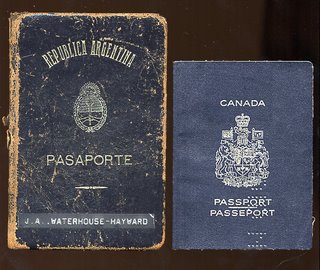
I will never forget what my half-brother Enrique told me, "Next time you come back to Argentina make sure you have a Canadian passport. My friend might not be around to help you." And so I applied for Canadian citizenship.
At the ceremony I was sitting next to a short Chinese man with black socks. I noticed that his first name was Aloysius. "Are you a priest I asked him?" He was. I showed him my father's King James bible on which I was gong to swear allegiance to the queen. He smiled as he showed me his Catholic bible and I felt close. We had a bond of sorts.
The event was recorded by my photographer friend Robert Blake (ex husband of Patricia Canning) who insisted that the event was an important one in my life. For me it was a practical procedure that would make traveling simple. But in the end Blake was right and I have come to realize how important it is to feel Canadian in a world of so many flags that more often than not are not up on a flag poles but stomped on by their would-be defenders. I have come to value our
Air
Space
& Water
I value our mostly unwavering 110 volts and precise 60 cycles. I value our more quiet form of "patriotism". It is fine with me if we are boring. The paradox is that in my new found Canadian identity my former Argentine one has fluorished with less cynicism. Both live in me without conflict. Could that be the Canadian way?
And best of all I often spot Patrick Reid walking in Kerrisdale and while no tears come to my eyes the feeling that life is good in Canada is reinforced.
Luís Miranda - The Best Uncle I Ever Had
Saturday, April 21, 2007
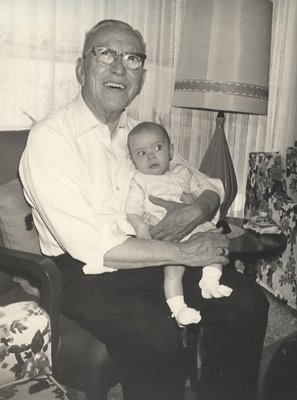
Luis Miranda was born in Manila and he was my grandfather Tirso de Irureta Goyena's first cousin. He was also related to him in some other way.
Ever since I first saw him in 1952 when Tío Luís moved with his family from Manila to Buenos Aires he was my favourite uncle even though he was always trying to make me eat. By the time we followed him to Mexico City and when I got married to Rosemary the nagging of not having eaten enough was transfered to her. In Mexico City as a young boy I loved going to Tío Luís's because he had a complete collection of Life Magazine from Pearl Harbour to Victory in the Pacific Day. I loved looking at the Sherman tank ads that boasted they had Buick Dynaflow transmissions. Tio Luis loved to tell me how Spanish galleons had sailed from Manila to Acapulco and transfered their cargo to move to Veracruz and from there to the magical city of Seville. It was Tío Luís who kept my Spanish in check as he spoke the most beautiful turn of the (20th) century Spanish which had been spoken in Manila. With my grandfather Tirso dead (I never met him) he was the only link to him besides my grandmother.
But Tío Luís is in today's blog for one important reason. He would be proud of me. In all the years that I knew Tío Luís I never understood why he liked opera and particularly the British variety. He often spoke of the Mikado and sang Madame Butterfly in the shower. He never tried to convince me about opera. Did he know I would go crazy for it someday? I was charmed by his opinion that going to the beach was over rated, "I hate going there as sand gets into my shoes."
In his day Handel operas were rarely staged. Abraham, Graham and John are coming for lunch today. We will then retire to the living room to listen to the Met live broadcast of the 3½ hour-long Julio Cesare. Wouldn't Tío Luís have been delighted?
In the picture here, he is with Rebecca's mother, my daughter Hilary when she was a few months old. Rebecca and Lauren will be with us today. I'll keep cool and like Tío Luís I will not proseltyze. But then Rebecca at 9 is smarter than her grandfather. She has seen Monteverdi's Orfeo and a Madame Butterfly rehearsal. Wouldn't Tío Luís have been proud of her?
John Cotton - Actor - Sailor - Hypnotist - Etc & The Can-can
Friday, April 20, 2007
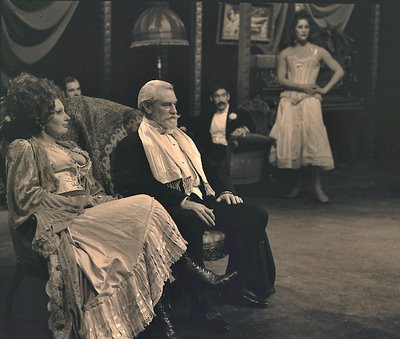
Today's blog could go in many directions but I will start it with Rebecca practicing a simple version of Offenbach's Can-can on our living room Chickering. Every time she plays it I remember the best can-can I ever saw. It was in Studio 40 at the CBC some 29 years ago.
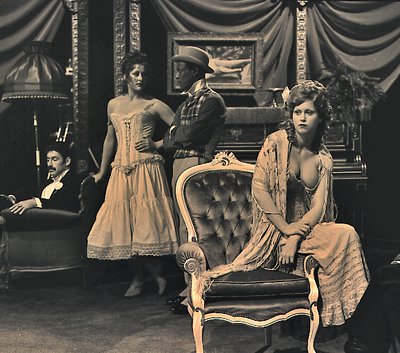
Leon Bibb was taping an extended show on the origins of the blues and jazz. The segment with the Can-can was performed in beautifully staged New Orlean bordello. The dancers were my favourite CBC jazz dancers including Viktoria Langton and Jackie Coleman.
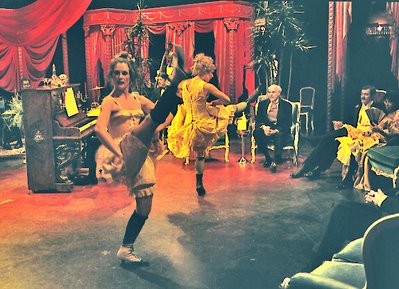
I was taking the stills and looking at my contact sheets I notice that during idle moments my camera was either trained on Langton or on Coleman. But I did take some pictures of a distinguished looking gentleman with all white hair who was supposed to be one of the patrons of the establishment.
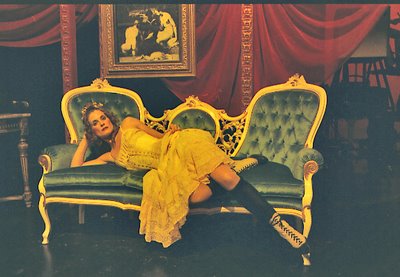
His name is John Cotton and we have been friends of sorts since. Circumstances get us together every once in a while. He is one of those persons that I often see walking on the Granville Street Bridge. Perhaps it has to do with his white hair. One of the last times I saw him he wanted to deal with my migraines by hypnotizing me. Somehow I declined his offer and my migraines have diminished with age.
Cotton called the other day to tell me about a PBS special on Patagonia. It ocurred to me that he would provide fine company for my friends Graham Walker and Abraham Rogatnick. We are having lunch at home tomorrow and then we will retire to the living room to hear the live radio broacast from the Met of Handel's Julio Cesare . I think that the four of us will have a great time.
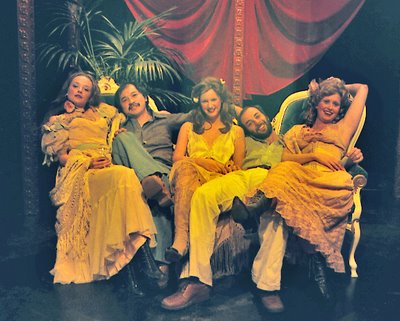
Looking at those negatives of so long ago I spotted a very special one that I had forgotten I had taken. The bearded man on the right is cameraman Mike Varga. And yes he had much more hair then!
Thursday, April 19, 2007
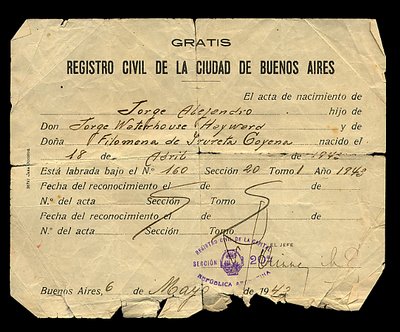
I was born on August 31, 1942 in Sanatorio Anchorena in Buenos Aires. My birth was recorded by a photographer with magnesium flash powder. The burst of light made me decide then and there that one day I would be a photographer.
------------------------------------------------
The above statement is false except for the fact that I was born in the mentioned hospital on that date in Buenos Aires. My birth certificate states I was born April 18, 1943.
Yesterday was my birthday but nobody called. Birth spoons, particularly those made and engraved by Mappin & Webb (which in 1942 and in 1943 had a Buenos Aires store) are supposed to be accurate. The clock is set for 2:50. My mother told me I was born early in the morning and further added that the proof that I had been born on a Monday was the fact I was a pain in the neck. The date is August 31, 1942. The spoon is the only "document" I have with a record of my true birthday.
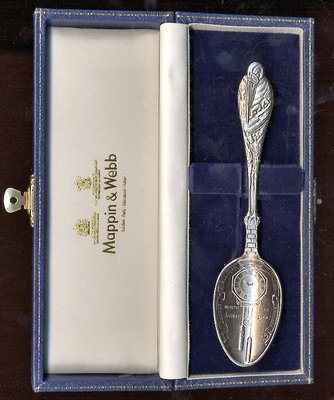
For all of my life I have celebrated August 31, 1942 but I have to be ready to respond to customs and border bureaucrats with the other one.
I hate all my birthdays. The official one does save me from embarrasment as it helps me to remember that today is Rosemary's. My mother always invited my school friends to a garden party. It featured a piñata, bag races and pin-the-tail-on-the-donkey. One of my classmates, the overly agressive Mónica would break all my toys and break the piñata. My cousins Georgito and Ricardo would gallop in with sneers in their faces and terrorize me. I hate cake of any kind. And it always rained. August 30th is St Rose of Lima's feastday. The storm that hits Buenos Aires near that date is called " la tormenta de Santa Rosa". I hate all my birthdays. I don't tell anybody when either of them is. But I still get depressed when nobody calls.
According to my mother, my father forgot to register me until almost a year later. Could this be true? Wouldn't he have to produce a live habeas corpus (me), a document of sorts, a doctor's signature? Was I that young looking even at the early age of almost one?
All my Argentine documents cite the April 18 birthday from my passports to that all important draft document (not anymore since President Menem abolished he draft) called a Libreta de Enrolamiento.
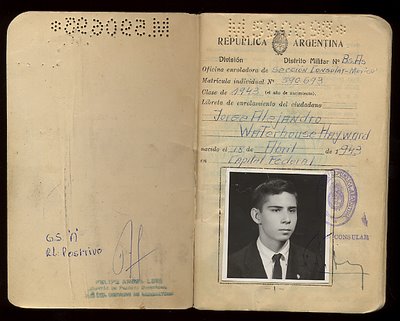
Then there is the problem of my name. My birth certificate states my father was called Jorge Waterhouse Hayward. In our family there was a tradition that the firstborn carried Waterhouse as the middle name. My uncle Harry was the firtsborn but I remember someone telling me that my grandmother Ellen Carter had not yet married my grandfather Harry when Harry Jr. was born. Technically he was not the firtborn but a bastard. Or perhaps my uncle Harry (who prepared a wicked salad and I fondly remember him putting sugar into his preparation of a Coleman's mustard salad dressing) didn't want to bother with the name. By 1942, 43 nobody in Argentina could legally have a foreign name (other than the surname). When the registrar objected to the Waterhouse my father explained it was part of the surname and slipped a bill (a coima) under the table.
But I was't the firstborn. Bastards seem to be a family tradition. My mother had revealed to me that my father had married a socialite from the Province of Salta and that the wedding had been blessed by the Salta bishop. It seems that in their wedding night my father's bride confessed to him that she was pregnant by another man and that she hoped that he would be an English gentleman and remain married to her long enough to give the child his name.
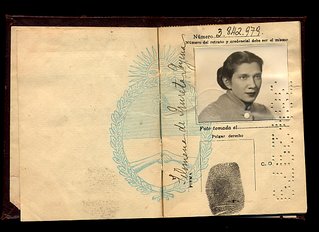
As a little boy I was never curious enough question that when we crossed borders my mother would tell me to be quiet and then when asked she would say her name was Filomena de Irureta Goyana. Why was her name different to mine? The document records that she is soltera or unmarried.
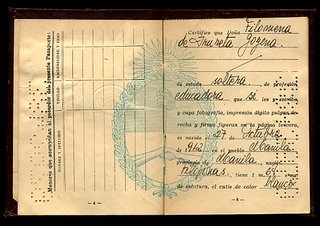
I did not know that at the time (in 1954 when you look at her Argentine passport of that date) Argentina did not recognize the divorce. I later remember, hazily that my mother and father married in Uruguay.
Eduardo Waterhouse (he dropped the Hayward) never met my father but looks exactly like him as they both resemble David Niven and share beautiful blue eyes. About 13 years ago I met his mother. Eduardo refused to accompany me and dispatched me with his son Patricio. Patricio's grandmother was gracious and served me empanadas salteñas. She spoke fondly of my father and told me how he had taught her to swim. My mother had been an exquisite swimmer and my father had taught her to dance the tango. My father danced the tango beautifully. When I asked the woman if my father danced she replied, "George, didn't."
I think my birth was much too complicated. My mother told me of all the effort she put in trying to get pregnant. It took her about five years and she had several miscarriages. To make sure I was a male she tried all kinds of concoctions like Coca Cola and vinegar.
I have thus decided that my death will be much simpler. I plan to die vaporized and I will leave no residue.
Today's blog title isn't entirely correct. Someone did call yesterday. I received a text message from Telus wishing me a happy birthday.
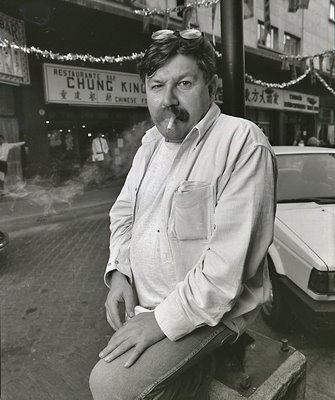
In 1997 when I had to choose a location to photograph one of my favourite Mexican (but Spanish born) authors, Paco Ignacio Taibo II it easy. It had to be an exotic place. A place that was both mysterious but prominent in his mystery novels. His odly named Mexico City private detective, Héctor Belascoarán Shaynem who has a fondness for Gerry Mulligan and Stan Getz also likes Chinese food. In Mexico City, for many years that was a problem. There was a Chinese restaurant in the Zona Rosa called the Luau which was expensive. And then there was the two block Callejón de Dolores, a narrow street by the Alameda Park. This was and still is the city's only China Town.
When I photographed Taibo there, the street seemed much too peaceful. In his novel The Shadow of the Shadow (1986, La Sombra de la Sombra) there is a big explosion and a fire-eating Chinese-Mexican union organizer, Tomás Wong could be the culprit.
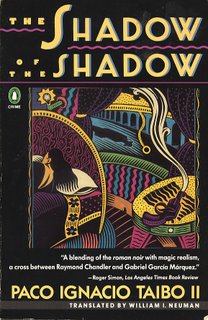
In my 18 years in Mexico I don't remember ever seeing any Chinese except the odd one on a bus and I would stare. To this day going for Chinese food in Vancouver has yet to lose its exotic nature for me.

I was born on August 31, 1942 in Sanatorio Anchorena in Buenos Aires. My birth was recorded by a photographer with magnesium flash powder. The burst of light made me decide then and there that one day I would be a photographer.
------------------------------------------------
The above statement is false except for the fact that I was born in the mentioned hospital on that date in Buenos Aires. My birth certificate states I was born April 18, 1943.
Yesterday was my birthday but nobody called. Birth spoons, particularly those made and engraved by Mappin & Webb (which in 1942 and in 1943 had a Buenos Aires store) are supposed to be accurate. The clock is set for 2:50. My mother told me I was born early in the morning and further added that the proof that I had been born on a Monday was the fact I was a pain in the neck. The date is August 31, 1942. The spoon is the only "document" I have with a record of my true birthday.

For all of my life I have celebrated August 31, 1942 but I have to be ready to respond to customs and border bureaucrats with the other one.
I hate all my birthdays. The official one does save me from embarrasment as it helps me to remember that today is Rosemary's. My mother always invited my school friends to a garden party. It featured a piñata, bag races and pin-the-tail-on-the-donkey. One of my classmates, the overly agressive Mónica would break all my toys and break the piñata. My cousins Georgito and Ricardo would gallop in with sneers in their faces and terrorize me. I hate cake of any kind. And it always rained. August 30th is St Rose of Lima's feastday. The storm that hits Buenos Aires near that date is called " la tormenta de Santa Rosa". I hate all my birthdays. I don't tell anybody when either of them is. But I still get depressed when nobody calls.
According to my mother, my father forgot to register me until almost a year later. Could this be true? Wouldn't he have to produce a live habeas corpus (me), a document of sorts, a doctor's signature? Was I that young looking even at the early age of almost one?
All my Argentine documents cite the April 18 birthday from my passports to that all important draft document (not anymore since President Menem abolished he draft) called a Libreta de Enrolamiento.

Then there is the problem of my name. My birth certificate states my father was called Jorge Waterhouse Hayward. In our family there was a tradition that the firstborn carried Waterhouse as the middle name. My uncle Harry was the firtsborn but I remember someone telling me that my grandmother Ellen Carter had not yet married my grandfather Harry when Harry Jr. was born. Technically he was not the firtborn but a bastard. Or perhaps my uncle Harry (who prepared a wicked salad and I fondly remember him putting sugar into his preparation of a Coleman's mustard salad dressing) didn't want to bother with the name. By 1942, 43 nobody in Argentina could legally have a foreign name (other than the surname). When the registrar objected to the Waterhouse my father explained it was part of the surname and slipped a bill (a coima) under the table.
But I was't the firstborn. Bastards seem to be a family tradition. My mother had revealed to me that my father had married a socialite from the Province of Salta and that the wedding had been blessed by the Salta bishop. It seems that in their wedding night my father's bride confessed to him that she was pregnant by another man and that she hoped that he would be an English gentleman and remain married to her long enough to give the child his name.

As a little boy I was never curious enough question that when we crossed borders my mother would tell me to be quiet and then when asked she would say her name was Filomena de Irureta Goyana. Why was her name different to mine? The document records that she is soltera or unmarried.

I did not know that at the time (in 1954 when you look at her Argentine passport of that date) Argentina did not recognize the divorce. I later remember, hazily that my mother and father married in Uruguay.
Eduardo Waterhouse (he dropped the Hayward) never met my father but looks exactly like him as they both resemble David Niven and share beautiful blue eyes. About 13 years ago I met his mother. Eduardo refused to accompany me and dispatched me with his son Patricio. Patricio's grandmother was gracious and served me empanadas salteñas. She spoke fondly of my father and told me how he had taught her to swim. My mother had been an exquisite swimmer and my father had taught her to dance the tango. My father danced the tango beautifully. When I asked the woman if my father danced she replied, "George, didn't."
I think my birth was much too complicated. My mother told me of all the effort she put in trying to get pregnant. It took her about five years and she had several miscarriages. To make sure I was a male she tried all kinds of concoctions like Coca Cola and vinegar.
I have thus decided that my death will be much simpler. I plan to die vaporized and I will leave no residue.
Today's blog title isn't entirely correct. Someone did call yesterday. I received a text message from Telus wishing me a happy birthday.
Exotic Chinese In Mexico DF
Wednesday, April 18, 2007

In 1997 when I had to choose a location to photograph one of my favourite Mexican (but Spanish born) authors, Paco Ignacio Taibo II it easy. It had to be an exotic place. A place that was both mysterious but prominent in his mystery novels. His odly named Mexico City private detective, Héctor Belascoarán Shaynem who has a fondness for Gerry Mulligan and Stan Getz also likes Chinese food. In Mexico City, for many years that was a problem. There was a Chinese restaurant in the Zona Rosa called the Luau which was expensive. And then there was the two block Callejón de Dolores, a narrow street by the Alameda Park. This was and still is the city's only China Town.
When I photographed Taibo there, the street seemed much too peaceful. In his novel The Shadow of the Shadow (1986, La Sombra de la Sombra) there is a big explosion and a fire-eating Chinese-Mexican union organizer, Tomás Wong could be the culprit.

In my 18 years in Mexico I don't remember ever seeing any Chinese except the odd one on a bus and I would stare. To this day going for Chinese food in Vancouver has yet to lose its exotic nature for me.
Tuesday, April 17, 2007
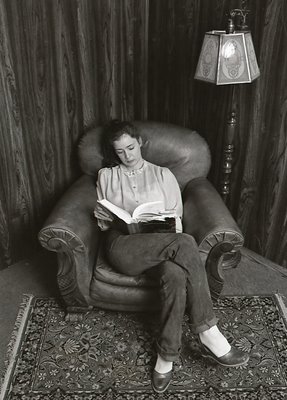
In 1981 I was a suitably conventional and boring 39-year-old man. My idea that sex was principally for procreation ( I had learned this in 4 years of a Catholic boarding school education in Austin, Texas) had been disturbed years back when my very sick 59-year-old mother, a couple of months before her untimely death, confessed to me that at her age, too many years of not having known a man had deeply depressed her and that she felt bitter.
In 1981 I ordered D.M. Thomas's The White Hotel from the Book of the Month Club. It was in this novel that I first began to understand a woman's mind and imagination and that they were not to be found with the ideal woman I had placed on a Dorian plinth.
It was also in 1981, when processing some film in my Burnaby basement darkroom, that I received a call from a young woman poet called Diana Hayes. She wanted to have her picture taken. She told me she was researching an article on exotic dancers and wanted to know what it was like so she wanted me to photograph her as if she were one.
I had photographed a few exotic dancers so I had a distorted belief that only women of that profession had an interest in undraping for a camera. Miss Hayes' request had me a tad confused. Nevertheless I did anticipate with a small amount of pleasure my appointment with her at her Kits home.
The photograph (top) is perhaps the only one of that first session that I can safely publish here. It hints that underneath a pristine, innocent appearance, lurks an imagination that is much richer and daring than that of any man, or at the very least, of this one. In our photographic relationship of many years, Miss Hayes constantly pushed on my photographic boundaries and the only force that thwarted her was my poor and slow imagination.
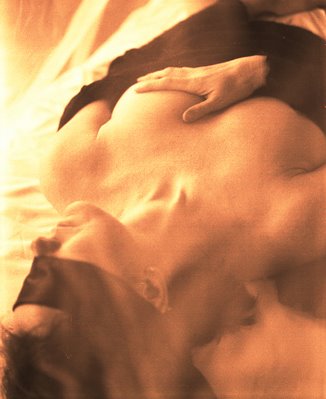
I just finished D.M. Thomas' Charlotte - The Final Journey of Jane Eyre and it led me to wonder what Diana Hayes was doing with her imagination. Her new webpage shows she has not rested on past laurels.
Diana Hayes
A Woman's Imagination
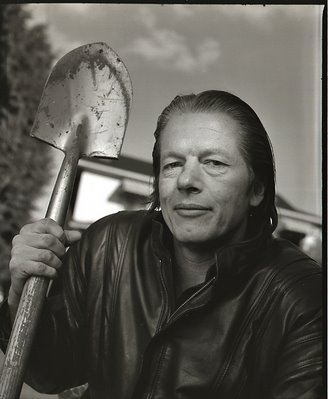
Some years ago Jim Christy, an infrequent visitor to my garden, suggested I needed a new path in my back garden. "This concrete path evenly divides it into two boring parts. You need a meandering curved one." So he began to build the path. With spade in hand he would look at me and then at Rosemary's black cat (he had a tendency to blink his big black eyes) and say, "He doesn't have too much upstairs, does he?" As Christy path approached the rear gate he looked at the nearby garage door and asked me, "What now?" I replied with one word, "Borges." Christy instantly knew. After all he had read Borges' story Garden of the Forking Paths, so much nicer sounding in its Spanish title El Jardín de Senderos que se Bifurcan. For close to three months my wife Rosemary nagged me every morning, "Christy's path is too curved and the stone is too pink."

Then one morning, as she looked out of the bedroom window, she saw Mosca walking on the path and she never nagged me again. Time and moss has muted the pinkness and both of us think of Christy often and wonder where he is. We haven't seen him for years. When in town he haunts the West End and the Sylvia Hotel.
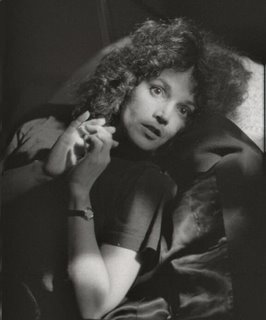
Christy, has always been secretive about his personal life. But I did meet his wife Mary Anne twice. Rosemary and I were once invited for dinner. Mary Anne had hypnotic black eyes and seemed to me to be a protagonist of a B Traven novel.
--------------------------------------------------------------
Had James Richard Christinzio not been born in Richmond, Virginia in 1945 and raised in South Philadelphia he would have been more at home in 19th century Victorian London. He and his pal Captain Sir Richard Francis Burton would have journeyed to Mecca, searched for the origin of the Nile and looked for gold in Brazil.
Christy came to Vancouver from Toronto in 1981 to promote his novel Streethearts and stayed. Some know him as the writer of offbeat articles on looking for treasure in Honduras or on the Victoria car thief who allowed Christy to watch him "work" for a week. Christy writes intelligent book reviews on such odd books as Jonathon Cott's The Search for Omm Sety. Few know that he has published at least eight books and finished six more. Few know that Christy is an artist, a gardener, an ex hobo, a dormant anarchist, an ex-American and lover of things Canadian or that he was a regular of American Bandstand and friend of the legendary jazz bassist and poet Chrlie Leeds. When Quest Magazine ceased publication in 1984 the screenwriter Norman Snider (Deadringers ) bemoaned its extinction in the Globe & Mail and wrote, "It gave a voice to a talented maverick like Jim Christy."
When Christy has not been writing or traveling, or working in a slaughterhouse ( "I did it for the money.") he usually works on his art. This could be his funny collage/sculptures he calls assemblages. "I started painting but I needed that other dimension." Many of them are about Catholic saints like his piece on St. Dominic, the patron saint of time. "I like the stories of the saints. Like St Martin of Porres, the Peruvian and first black saint and patron saint of dog lovers. I like the stories even if they are not true. I like it when orthodox Catholicism meets the pagan and the changes each undergoes." These sculptures are full of little details.
In his writings Christy cites long forgotten writers, or not so forgotten like B Traven ("I met him."), boxers and fire breathers. "I like little details." Of his art he says, "It's fun, It's funny and it shows a side of me that gets into the writing a bit. It's kind of goofy, it has a sort of askew charm to it, even if I say so myself."
In one of the chapters of one of his books on boxing, Flesh and Blood Christy writes in admiration of Vancouver boxer Jamey Ollenberger. "When I first saw him, Ollenberger was holding down three jobs: grounds keeper and gravedigger at a cemetery during the day, aerobics teacher at night, and a Saturday stint moving furniture at a department store. Somehow he managed to put in his hours at the gym, and to fight." When I asked Christy if he had ever dug graves he looked at me and smiled.

In 1981 I was a suitably conventional and boring 39-year-old man. My idea that sex was principally for procreation ( I had learned this in 4 years of a Catholic boarding school education in Austin, Texas) had been disturbed years back when my very sick 59-year-old mother, a couple of months before her untimely death, confessed to me that at her age, too many years of not having known a man had deeply depressed her and that she felt bitter.
In 1981 I ordered D.M. Thomas's The White Hotel from the Book of the Month Club. It was in this novel that I first began to understand a woman's mind and imagination and that they were not to be found with the ideal woman I had placed on a Dorian plinth.
It was also in 1981, when processing some film in my Burnaby basement darkroom, that I received a call from a young woman poet called Diana Hayes. She wanted to have her picture taken. She told me she was researching an article on exotic dancers and wanted to know what it was like so she wanted me to photograph her as if she were one.
I had photographed a few exotic dancers so I had a distorted belief that only women of that profession had an interest in undraping for a camera. Miss Hayes' request had me a tad confused. Nevertheless I did anticipate with a small amount of pleasure my appointment with her at her Kits home.
The photograph (top) is perhaps the only one of that first session that I can safely publish here. It hints that underneath a pristine, innocent appearance, lurks an imagination that is much richer and daring than that of any man, or at the very least, of this one. In our photographic relationship of many years, Miss Hayes constantly pushed on my photographic boundaries and the only force that thwarted her was my poor and slow imagination.

I just finished D.M. Thomas' Charlotte - The Final Journey of Jane Eyre and it led me to wonder what Diana Hayes was doing with her imagination. Her new webpage shows she has not rested on past laurels.
Diana Hayes
A Woman's Imagination
Jim Christy, B Traven , Borges & A Hard Working Boxer
Monday, April 16, 2007

Some years ago Jim Christy, an infrequent visitor to my garden, suggested I needed a new path in my back garden. "This concrete path evenly divides it into two boring parts. You need a meandering curved one." So he began to build the path. With spade in hand he would look at me and then at Rosemary's black cat (he had a tendency to blink his big black eyes) and say, "He doesn't have too much upstairs, does he?" As Christy path approached the rear gate he looked at the nearby garage door and asked me, "What now?" I replied with one word, "Borges." Christy instantly knew. After all he had read Borges' story Garden of the Forking Paths, so much nicer sounding in its Spanish title El Jardín de Senderos que se Bifurcan. For close to three months my wife Rosemary nagged me every morning, "Christy's path is too curved and the stone is too pink."

Then one morning, as she looked out of the bedroom window, she saw Mosca walking on the path and she never nagged me again. Time and moss has muted the pinkness and both of us think of Christy often and wonder where he is. We haven't seen him for years. When in town he haunts the West End and the Sylvia Hotel.

Christy, has always been secretive about his personal life. But I did meet his wife Mary Anne twice. Rosemary and I were once invited for dinner. Mary Anne had hypnotic black eyes and seemed to me to be a protagonist of a B Traven novel.
--------------------------------------------------------------
Had James Richard Christinzio not been born in Richmond, Virginia in 1945 and raised in South Philadelphia he would have been more at home in 19th century Victorian London. He and his pal Captain Sir Richard Francis Burton would have journeyed to Mecca, searched for the origin of the Nile and looked for gold in Brazil.
Christy came to Vancouver from Toronto in 1981 to promote his novel Streethearts and stayed. Some know him as the writer of offbeat articles on looking for treasure in Honduras or on the Victoria car thief who allowed Christy to watch him "work" for a week. Christy writes intelligent book reviews on such odd books as Jonathon Cott's The Search for Omm Sety. Few know that he has published at least eight books and finished six more. Few know that Christy is an artist, a gardener, an ex hobo, a dormant anarchist, an ex-American and lover of things Canadian or that he was a regular of American Bandstand and friend of the legendary jazz bassist and poet Chrlie Leeds. When Quest Magazine ceased publication in 1984 the screenwriter Norman Snider (Deadringers ) bemoaned its extinction in the Globe & Mail and wrote, "It gave a voice to a talented maverick like Jim Christy."
When Christy has not been writing or traveling, or working in a slaughterhouse ( "I did it for the money.") he usually works on his art. This could be his funny collage/sculptures he calls assemblages. "I started painting but I needed that other dimension." Many of them are about Catholic saints like his piece on St. Dominic, the patron saint of time. "I like the stories of the saints. Like St Martin of Porres, the Peruvian and first black saint and patron saint of dog lovers. I like the stories even if they are not true. I like it when orthodox Catholicism meets the pagan and the changes each undergoes." These sculptures are full of little details.
In his writings Christy cites long forgotten writers, or not so forgotten like B Traven ("I met him."), boxers and fire breathers. "I like little details." Of his art he says, "It's fun, It's funny and it shows a side of me that gets into the writing a bit. It's kind of goofy, it has a sort of askew charm to it, even if I say so myself."
In one of the chapters of one of his books on boxing, Flesh and Blood Christy writes in admiration of Vancouver boxer Jamey Ollenberger. "When I first saw him, Ollenberger was holding down three jobs: grounds keeper and gravedigger at a cemetery during the day, aerobics teacher at night, and a Saturday stint moving furniture at a department store. Somehow he managed to put in his hours at the gym, and to fight." When I asked Christy if he had ever dug graves he looked at me and smiled.
Sunday, April 15, 2007
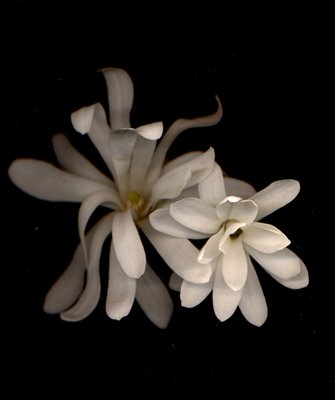
Many plants in our spring garden are too small to really notice unless you know about them. Such is the case of the epimediums. At this time of the year we cut off last year's leaves while having to be careful not to cut off the fresh new stems with the little flowers. I am so used to seeing the forsythia's Yellow Cab yellow flowers that my only connection is the knowledge that I should have pruned my roses by now. In many gardening circles the flowering of the forsythia is a rose pruning indicator.
The rhodos are difficult to ignore at this time of the year, particularly my early blooming ones like Rhododendron augustinii, Rhododendron racemosum and a new one I purchased last year at the VanDusen plant sale, Rhododendron williamsianum.
The four camellias are in bloom, Camelia japonica (a white one and a hot pink one), Camellia x williamsii ‘Donation’ and Camellia x williamsii 'Aunt Mavis'.
But it is our Magnolia stellata with its startling cool white flowers that I cannot but notice and feel that spring is really here. The small tree is by our kitchen bed and it replaced a dead Lawson Cypress about 15 years ago. I found it espaliered against a wall in a nearby house (Hudson and 43d) that was about to be demolished. I obtained permission from the developer to bring it home and it has flourished since.
Magnolia stellata unlike many magnolias is not fragrant. Some 10 years ago I planted a Magnolia grandiflora also called the Southern Magnolia. It's huge and also white flowers bloom later in spring and their scent must be proof that if heaven does not happen to exist "up there" it exists right here. But magnolias are like cats and babies and they don't perform on demand. My grandiflora has yet to bloom. The hope that it might is what makes gardening so exciting.

Many plants in our spring garden are too small to really notice unless you know about them. Such is the case of the epimediums. At this time of the year we cut off last year's leaves while having to be careful not to cut off the fresh new stems with the little flowers. I am so used to seeing the forsythia's Yellow Cab yellow flowers that my only connection is the knowledge that I should have pruned my roses by now. In many gardening circles the flowering of the forsythia is a rose pruning indicator.
The rhodos are difficult to ignore at this time of the year, particularly my early blooming ones like Rhododendron augustinii, Rhododendron racemosum and a new one I purchased last year at the VanDusen plant sale, Rhododendron williamsianum.
The four camellias are in bloom, Camelia japonica (a white one and a hot pink one), Camellia x williamsii ‘Donation’ and Camellia x williamsii 'Aunt Mavis'.
But it is our Magnolia stellata with its startling cool white flowers that I cannot but notice and feel that spring is really here. The small tree is by our kitchen bed and it replaced a dead Lawson Cypress about 15 years ago. I found it espaliered against a wall in a nearby house (Hudson and 43d) that was about to be demolished. I obtained permission from the developer to bring it home and it has flourished since.
Magnolia stellata unlike many magnolias is not fragrant. Some 10 years ago I planted a Magnolia grandiflora also called the Southern Magnolia. It's huge and also white flowers bloom later in spring and their scent must be proof that if heaven does not happen to exist "up there" it exists right here. But magnolias are like cats and babies and they don't perform on demand. My grandiflora has yet to bloom. The hope that it might is what makes gardening so exciting.
Saturday, April 14, 2007
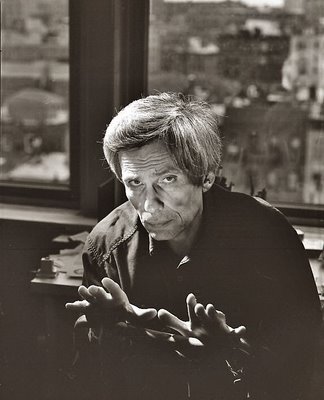
Alas when I wrote this review for Duthie's Reader in 1995 how was I to know that Jerome Charyn would retire the "Pink Commish" Isaac Sidel and that I would have to satisfy my appetite for Charyn books with some not so satisfying books as a treatise on ping-pong (never table tennis) Sizzling Chops & Devilish Spins - Ping-Pong and the Art of Staying Alive (2001). Or I would polish off in an evening his slim autobiographical books like the one about his mother The Dark Lady From Belorusse (1997). Like most Chinese/Roumanian food these books left me hungry for more.
---------------------------------------------------------------
I'd lapsed into illiteracy after the High School of Music and Art. I could spell, yes...and think a little. I hadn't forgotten Modigliani. I'd pick up girls at the Metropolitan Museum of Art. I'd wander to the Frick Collection, stand in front of Rembrandt's Polish Rider, wait for that light, lovely sound of the Frick waterfall. I'd been a cartoonist once. I could draw every hair on King Kong's head and paint his blue nostrils. But I wanted to be Modigliani and elongate everything with hands, feet and faces were stretched out ike a choo-choo train. I was a counterfeiter. Modigliani manqué. - From Metropolis (1986)
By 1973, Bronx author Jerome Charyn, then thirty-six, had written seven novels. Each one had "sunk into invisibility". He decided to "scribble a crime novel". He invented a New York tribe of pork-eating marrano pickpockets, the Guzmanns (from Lisbon via Lima), angels of doom in the fall of Ping-Pong-playing NYPD homicide detective Manfred Coen in Blue Eyes.
Isaac Sidel, a character who haunts Blue Eyes, comes back in three more of
Charyn's crime novels, himself haunted by the dead Blue Eyes. Blue Eyes, Marilyn the Wild, The Education of Patrick Silver, and Secret Isaac are known as The Isaac Quartet. Beginning in 1990, Charyn wrote four more, The Good Policeman, Maria's Girls, Montezuma Man and Little Angel Street, collectively The Odessa Quartet. In the eight novels (all published my Mysterious Press) Isaac Sidel rises from first deputy police commissioner to commissioner(in which he uses a desk of that other famous commish, Teddy Roosevelt) and then in Little Angel Street to mayor elect of New York.
I was in Jerome Charyn's Greenwich Village apartment in October, 1995 and I asked him why Isaac Sidel always cried. Charyn replied, "In our culture it's considered effeminate. It condemns emotion in men. I like Isaac to be as if his whole body, everything about him, could express his feelings, from his tapeworm, to his sideburns, to his tears. He's someone who bleeds. His feelings erupt quickly. I like the idea of men crying."
While sipping my tea I watched Charyn's intense eyes and recalled a description of him by his friend Mexican writer Paco Ignacio Taibo II": the Vampire of Manhattan-Paris". (When Charyn is not in New York he lives in Paris in a flat overlooking Montparnasse cemetery.) I asked Charyn why he isn't rich and famous. In a resonant voice (Manfred Coen's, Isaac Sidel's?) he replied, "My use of language is very particular and it's something that many people cant'deal with. To me everything is in the language. Am I realy a crime writer? A mystery writer? When the French look at it they look at in in terms of the metaphysics. They understand what I am trying to do. I don't think the Americans really do. My books are linguistic attacks that happen to to talk about cops. I'm not intersted in catching the crook. They are a shadow land where good and evil just come together and you can't tell the difference."
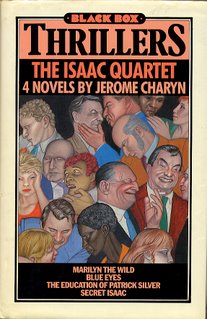
Charyn describes his writing as "scratchy, secretive as a snake". Whatever it is, it a takes a bit fo trying to understand, but it will soon seduce you as it did me. Charyn's Isaac books are full of Roumanians(why Roumanians? "There are many in my apartment building"), odd characters with a fondness for frozen Milky Ways, people who get Glocked rather than killed, Zen descriptions of the advantages of Butterfly Ping-Pong bats (never paddles!) over sandpaper one, frequent diatribes on the loss of the New York Giants and baseball during World War II, of antiquarian baseball leauges, of Herman Melville, James Joyce, men that cry often, and the city of Carcasonne. Then there is Margaret Tolstoy, sometimes Anastasia, who wears wigs, carries a Glock, breaks Isaac's heart, and works for Frederick LeComte, the cultural commissa of the FBI, a villain in a blue suit. (Charyn named LeComte after a college professor who rejected his early attempts at writing.)
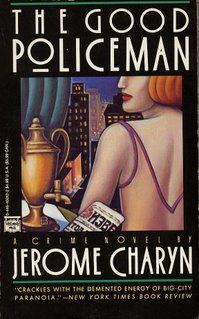
Between 1973 and 1994 Charyn wrote eleven other novels (including, in 1985, War Cries Over Avenue C a horrific book about Vietnam that Charyn describes as "a hallucination that hss the very fabric of New York") and a non-fiction book about New York Metropolis (my favourite book ever about the city), Darlin' Bill, a fantasy about "Will Bill" Hickok, won Charyn the Richard adn Hinda Rosenthal Foundation Award of the American Academny and Intitute of Arts and Letters in 1981. Asked about the award shortly afterterward, Charyn said, "It is given to 'that novel that is a commercial failure but is nevertheless a literary achievement'. You have to lose in order to win. In past years it's been won by Joyce Carol Oates, John Updike, Philip Roth, Thomas Pynchon and Bernard Malamud."
That Charyn isn't rich or famous I take as highly subjective but simple proof that God does not exist.
Note: In Charyn's last Isaac Sidel novel, Citizen Sidel (1999), the former commish becomes Vice President Elect of the United States. I am not sure if my favourite New York Times columnist, Maureen Dowd, has ever read Jerome Charyn. Her columns somehow remind me of Charyn's scribbles. All of Charyn's Isaac novels (and a couple non-Issac featuring retired hitman Sidney Holden, Elsinore and Paradise Man ) were designed and illustrated by the mysteriously named Bascove (above, left). While in New York in 1995 I did get to meet Bascove. Bascove was a very short and energetic young woman.
While I learned to perfect my ping-pong on the pitching deck of an Argentine Navy ship I had the impression that even with a Butterfly bat in my hand I would have been soundly defeated by Charyn.
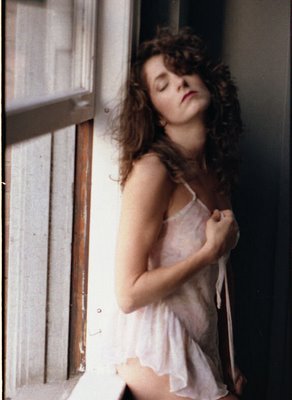
There is a sweet spot where the bum of a woman suddenly becomes the thigh. I believe that it does not have a name. It should, because it is one of the most beautiful places on the human body.
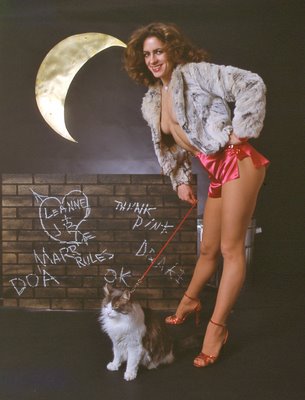
And the most beautiful example of that most beautiful unnamed spot belongs to my friend Tarren. I have had the privilege to observe it in great detail in the almost 28 years that I have had the good fortune to take her photographs. Now Tarren's unamed spot is particularly beautiful because she happens to have one of the most beautiful bums and legs I have ever seen.
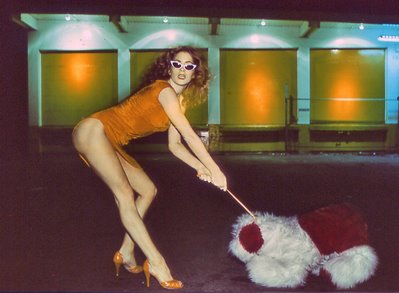
I will post here several photos to prove my point. She somehow posed a few times with furry friends both real and artificial. She even posed with my cat Gaticuchi in my home studio in Burnaby.

I have been prompted to post the photographs because today I am invited to celebrate Tarren's 50th birthday. I have been thinking about her as I sorted through my thick Tarren photo file. Have I been lucky?

Yes, specially as I have seen her mature and become a bit older than those 22 years she had when I first saw her. I will be a bit difficult for me to confirm tonight if her unamed spot is as good as ever. It is my suspicion that it is.
Much More Tarren

Kurt Vonnegut 1922- 2007
Until 1964 I read every science fiction book I could find. I started this craze of mine around 1955 when I lost interest in reading about Achilles, the Greeks, the Trojans and the Spartans. That is how I first started reading Kurt Vonnegut. In 1952 he wrote Player Piano and in 1959 The Sirens of Titan. He was considered a science fiction writer much as Gore Vidal.
In 1958 I bought my first serious camera, a Pentacon F with a Jena made 50mm F-2.8 Tessar lens. On the bottom of the camera, embossed on the leather, it read "Made in USSR Occupied Zone.
The Pentacon traveled with me to Buenos Aires in 1965. In the first few months of my stint in the Argentine Navy I stayed with my mother's friends the American Sullivan family. The oldest son, John Sullivan was a conscript in the Argentine army. Since he had been educated in the US he was much older than the official age of 20. So John was 4 years older. At the time I felt I was an idealist and my world was black and white. John and I had massive arguments as he stated that the world was not cut and dry and that its colour was gray. He said that absolutes only existed in mathematics and science and in all other cases it was all relative.
In 1971, I had been married to Rosemary since 1968, she and I went to the American Mexican Institute of Cultural Relations ( a front for CIA) to listen to a lecture by Kurt Vonnegut. In his lecture (both Rosemary and I were charmed by his warm demeanor) he asserted that he had coined the term "open beaver". It was about then that I read Slaughterhouse Five and came to understand how right John Sullivan had been.
In Slaughterhouse Five I read how the Americans had sent bombers equipped with demolition bombs followed by British bombers with incendiary bombs. Some general had calculated how long it would take for neighbouring fire departments to send equipment into the fire bombed Dresden before unleashing another wave of bombers. I realized that my idea of good and evil, black and white was all wrong. John Sullivan had been right. The image of a raging lion escaping the Dresden zoo in the firestorm has been etched in my mind since. Vonnegut took care of eliminating that naivite of my youth.

Last year I read W. G. Sebald's horrific On the Natural History of Destruction and somehow it wasn't so horrific. Perhaps I had been deadened a bit by Vonnegut back in 1970. That Sebald, a German writer of note would die in an automobile accident in Norfolk, England in 2001 makes me suppose that Billy Pilgrim would have said, "and so it goes."
And yes that shattered Russian zone where the body of my Pentacon F was made was a quickly re-built Dresden.
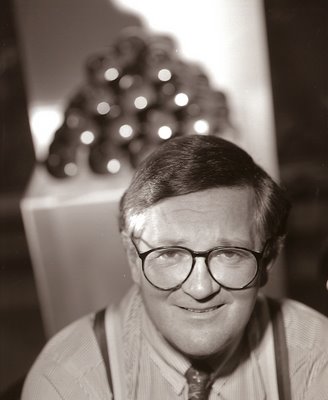
For photographers in Vancouver the 80s were very good if you worked for the many business magazines that were around as I did. I made very good money. I don't feel too guilty as I really had to earn my money. For Weyerhaeuser I made several trips to Kamloops and walked miles looking for the "perfect" forest to photograph. For Wellwood Forest Products I braved minus 20 degree temperatures in Alberta to photograph mills at 2 a.m. Things got marginally better when I photographed the two
MacMillan Bloedel executives every year for many years. They were urbane, interesting and their office was here in Vancouver. I photographed many other forest product industry honchos and most of them were boring, very straight and the reading material in their reception offices (where I spent long hours waiting for them to give me the time of day) consisted of tractor brochures and infinitely boring forest industry trade magazines.
There was one exception and that was Lignum's Jake Kerr. His reception room at his office on West Georgia Street was decorated with Christopher Pratts. There were no forestry trade manuals but many interesting arts magazines and books. I could have easily waited for hours with such reading material.
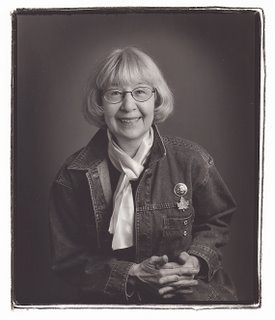
In his office, the two times I visited Kerr, he had a pile of very red Gathy Falk (at right) apples sitting on a tall white plinth. I recall also seeing a Joe Fafard sculpture.
This does not mean that Kerr was completely the atypical BC forest product executive. I remember seeing him dressed in work boots and work clothes at the private jet terminal Esso Avitat in Vancouver. I was off to San Miguel de Allende for a magazine and Kerr was there surrounded by several men. When he said, "Let's go!" they all got up in unison and followed him out to the waiting jet. My guess is that Jake Kerr and all those others I photographed represent a end of an era.
Today I read in the Vancouver Sun an announcement that Jake Kerr has been appointed Chair of the Vancouver Foundation. If there is anybody who can promote and help the arts in Vancouver he has to be the man.
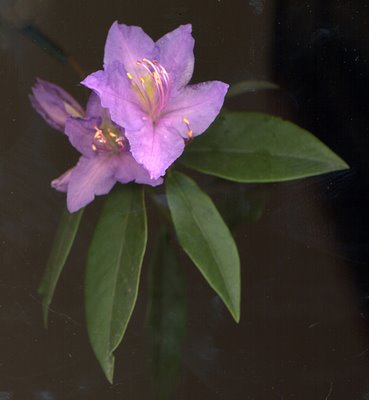
Yesterday morning when I looked through the window of my living room I saw masses of blue/lilac buds on a shrub that is dear to my heart. Perhaps ten years ago Kaponga (New Zealand) born plantsman (this is the term he prefers to describe himself) Alleyne Cook showed up in my garden with a pot that had a sorry stick emerging from it. "Alex you must have Rhododendron augustinii in your garden. Cook pronounces botanical names his own way and refuses to acknowledge the syllable that separates the two Is in the species name augustinii. We argued about it but then we both love to do that.
Rhodendron augustinii and Rhododendron racemosum are the first rhodos to bloom in my spring garden. This species rhodo is extremely popular as it is one of the few that approaches the colour blue. Strange as it may seem the island of Rhodes is named after the Greek word for rose or rhodon. Rhododendrons were perhaps given that name because of a similarity to the colour of roses. But both rhodos and roses share an inability to produce a pure blue flower.
Alleyne Cook told me, "Everybody thinks his or her augustinii is different so there are countless named cultivars." I tried to nail Cook down with some basic info on augustinii and he was most forthwith. It has all to do with the colour of the flower's throat. The perceived colour of this rhodo has a lot to do with it. If the throat is yellow or green the overall shift of the flowers will be from red to the blue spectrum while if the throat is maroon the shift will be towards the lilac. And then there are augustinii that are darker and others that are lighter.
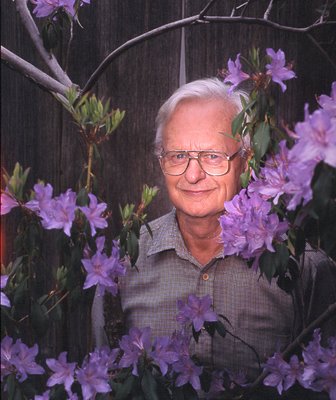
Cook found a variety in his garden that was between two that were very dark and it had a yellow green throat. He named his plant Rhododendron augustinii 'Marion McDonnell' after his friend, Vancouver's "Blue Poppy Lady", Marion McDonnell. You can see him here proudly posing with her in his garden.
It is always a pleasure to visit or be visited by the Cooks. They are a perfect blend of charm with punctilious erudition.
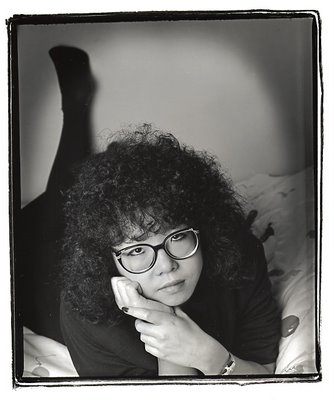
When the phone rang before 9 a.m. in the late 80s I was generally prepared for an urgent request for a photo of Vancouver writer Evelyn Lau to be sent pronto by Fedex (this was well before the press & send digital revolution). Those requests came from publishers and magazines in London, Tokyo, Copenhagen and once even from Sao Paulo.
Those lucrative awakenings began with an early-morning call from Toronto literary agent Denise Bukosky in December 1988. I was to photograph a 17 year-old girl, Evelyn Lau, for the cover of her book Runaway: Diary of a Street Kid. Based on a diary she started at 14, it details her experiences living on the street and her struggles with drugs, prostitution and attempted suicide. Nancy Flight, her editor, was to be my local contact.
When I met up with Flight in February 1989, outside Evelyn's rented suite, Flight's demeanour was glacial. Flight had called me a week before to ask for my studio address. I had replied, "I am going to photograph her where she lives. She will be more at ease. And I'll pose her on her bed. I's sure she has a young girl's beadspread." The silence on the line was eloquent. It didn't seem to help when I explained that I had a daughter of the same age and that I had photographed her on her bed. Flight stressed, "I'm going to be there."
Although the poised 17-year-old Lau seemed to be an adult (much more so than my daughter), she didn't think twice about my request. After all, she was also a teenager. I wasn't disappointed; her beadspread featured red balloons. Although another photo, not on the bed, taken later that day was ultimately used for the cover, I still treasure that first exposure of Evelyn on her bed with her dark-rimmed glasses.
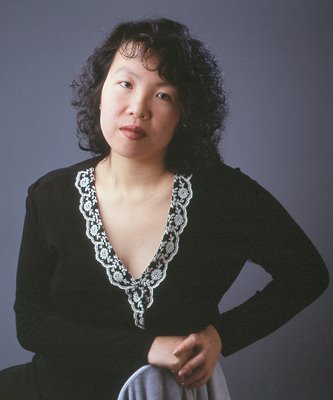
She was to pose for me many times and here is one of my favourites as a mature woman (1990) who is most womanly and feminine.
Evelyn Lau, Elmore Leonard & John Lekich
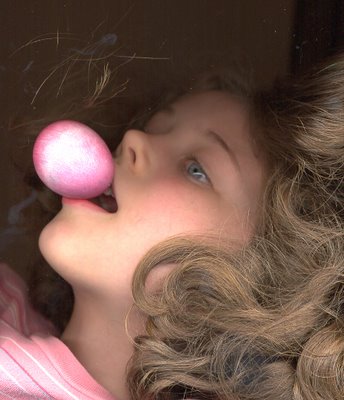
Rebecca and Lauren reversed roles with me yesterday at Granville Island. Rebecca had no ballet at Arts Umbrella and Lauren had a birthday party at Kids Only there, This meant that it was not Lauren but Rebecca with whom I had tea at the Granville Island Tea Company. Rebecca insisted we go to the Salmon Place to look at the trouts. It was here that I bought the trout for the picture of Jonathon Young as Trout Stanley. We also had a chat with carver artist Todd Woffinden and we asked him of the status of his partner Andrea Hodge. She is expecting in June. I believe that for Rebecca's birthday I may have to buy for her one of Todd's beautifully carved whale tales.
Yesterday was a pleasant sábado de gloria. I listened to Giordano's Andrea Chenier live from the Met (with no less than Ben Heppner in the title role) in CBC's Saturday Afternoon at the Opera.
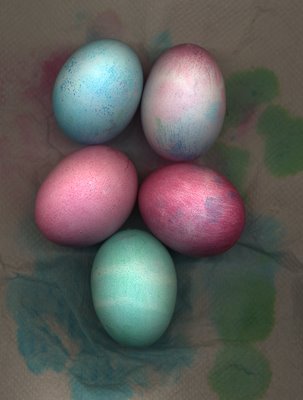
At my request Rebecca coloured some Easter eggs and promptly dripped some purple dye on our living room's white sofa. I became a little furious. Once I got over with that we did the three scans you see here.
It is my Argentine nephew Georgito O'Reilly who says the most important activity of our existence is to converse and share food with our children, grandchildren and family. He is right.
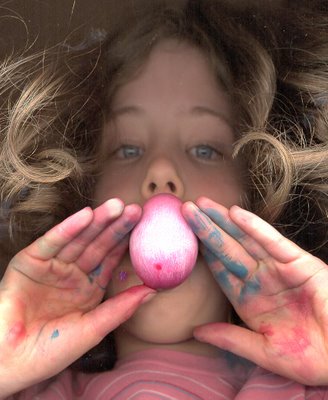
Rosemary and I rounded out the day by enjoying a powerful, off the wall and really very funny Trout Stanley at Performance Works on Granville Island where I had begun my day. We both look forward to serving a meal to our family this afternoon.
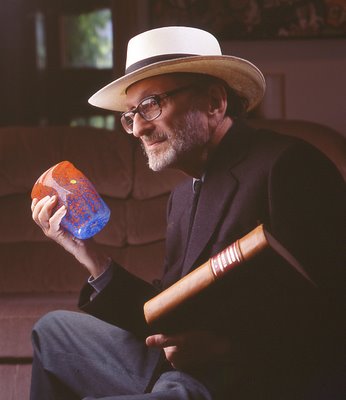
As I sat in the front pew of St Helen's Anglican Church with Abraham Jedediah Rogatnick yesterday evening I had thoughts of my grandmother Lolita and how she directed the Good Friday activities at home in Buenos Aires when I was a boy.
I had called Abraham in the morning to tell him that an unusual version of Mozart's Requiem was being Performed at St Helen's. The Vancouver Voices Quartet and Vancouver Chamber Players were performing the Requiem with only four voices and accompanied by a string quartet.
Many if not most of the patrons seemed to be parishioners of St Helen's (named after Constantine the Great's saintly mother). And there we were, a Catholic and a Jew sitting there discussing how three of the four singers had faulty Latin diction.
Perhaps my grandmother would have been shocked at it all or perhaps her anti-semitic stance was only Spanish 19th century upbringing. On Good Fridays I was not allowed to turn on the radio and sometime around 3 pm we would kneel on the living room floor in our Coghlan home and she would take us through the stations of the cross in Latin. I distinctly remember her telling me how the evil Jews had crucified Him. When describing people's faces she would sometimes say, "She has the map of Jerusalem on her face." Or she would switch to her alternate, "He is one of Jesus' countrymen."
But she never ever uttered a critical word about my best friend who lived across the street on Melián 2779. He was Mario Hertzberg. He, Miguelito (I have long forgotten his Calabarian surname) and I were inseperable and we were known as the inglesito (the english boy) el tano (the Italian) and el judío (the Jew).
Mario had two brothers but he once showed me the photograph of a third who looked much the same as he did except he was fatter and wore glasses. "That was my older brother but he died at a place called Auschwitz."
At age 8 I did not have enough curiousity to pursue the subject any further.
One day Mario and I went to see a Tarzan movie at the Saturday series sponsored by our local Capucine monks who were building a very large new church next door to the little community center and movie house. They charged us a token fee but we knew our money was going to a good cause. As we left after the show we were approached by a chubby Capucine who asked us our names. He asked me to what church I went to. When he questioned Mario, Mario replied, "I don't go to church I am a Jew." I will never forget the Capucine's smile as he placed his hand on Mario's arm and told us, "We share the same God and that is what is important." I thought about that for the rest of the day but I never confronted my grandmother with what to me was a clear difference of opinion.
I lost track of Mario Hertzberg when I was 20 but when I am with Abraham, even though he is 85, I find in his warm companionship, traces of that boyhood friendship that I miss but that somehow have come back.
It is appropriate that I write of this today. In Spanish, we call today Sábado de Gloria . It is an important day in Catholic liturgy as Catholics meditate on Easter Sunday. Easter Sunday is the most important feast day of them all. If the Man does not come back from the grave tomorrow it is all words and nothing more.
In my own little way I discovered last night as Abraham and I heard the lyrics:
tuba mirum spagens sonum (the trumpet will send its wondrous sound)
of a friendship reborn.
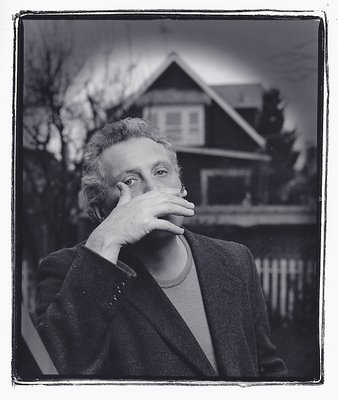
Michael John Dibdin, novelist, born March 21 1947; died March 30 2007.
I would have never known except for my tenacious information freak friend Mark Budgen who found out from a Guardian podcast. Budgen is one of those eccentric Englishmen who somehow jumped from LP records, bypassing the tape and CD era, straight into the iPod.
I met Michael Dibdin three times. The second time I traveled to Seattle to interview him for Celia Duthie's wondrous little gem, The Reader. He opened the door of his modest house while a woman next door eyed me while weeding, She was Dibdin's wife, ( his third and last), crime writer Kathrine Beck. They each wrote in their respective house but I didn't dare ask about their sleeping arrangement. Mark Budgen's contribution to my false, based in fear, diplomacy would have been, "Good for you, Alex." Budgen is an expert on living the life of two simultaneous households.
If I were to cite my favourite mystery book of all the ones I have ever read (I am having a hard time not considering our very own Canadian J. Robert Janes's excellent St-Cyr/Kohler mysteries) it would be Dibdin's definitive Venice based 1994 mystery novel Dead Lagoon. I will re-publish below my review that appeared that year in The Reader.
The Dead Lagoon
An Aurelio Zen Mystery by Michael Dibdin
Harper Collins Publisher Ltd, Toronto, 297 Pages, $25.00
Reviewed by Alex Waterhouse-Hayward
After finishing the Dead Lagoon , Aurelio Zen fans might think that Aurelio is in State Railways car compartment on his way home to Rome to his dotty mother Giustiniana. They might further think that he will try to patch up his eroding relationship with the fiery tempered Tania. They would we wrong - Aurelio Zen is actually living quietly in a modest house in the Wallingford neighbourhood of Seattle, with his friend Kathrine(crime writer K.K. Beck) and her extensive collection of Agatha Christie hardbacks. At least that's what I thought when Michael Dibdin opened the door on a morning in late February, 1995 puffing one of Aurelio's "camelshit Nazionali." Alas, I found out they were Marlboro Lights when we were sipping our strong expressos - not even Aurelio's usual caffé corretto with the added shot of grapa.
What had led me to that pleasant morning with Dibdin? ("His expression is stern, almost saturnine, yet his manner is courteous and respectful, " a description of Aurelio Zen in the Dead Lagoon fits Dibdin admirably,)in my search for Reginald Hill, Colin Dexter and Paco Ignacio Taibo II novels, my requests for new inspector Morses. Belascoarán Shynes and Dalziel and Pascoes at Duthie's, The Mystery Merchant Bookstore and Granville Books were frequently answered with a persistent, "No, but have you tried Dibdin's Aurelio Zen?"
Nine books later I am a fan. Michael Dibdin's ouput is divided into what he calls his "stand-alone novels", Dirty Tricks, The Last Sherlock Holmes Novel where Holmes, Moriarty and Jack the Ripper develop a very intimate relationship), The Tryst, A Rich Full Death, The Dying of the Lightand the four Aurelio Zen novels: Ratking, Vendetta, Cabal and Dead Lagoon. The hero is a Venetian-born plainclothes Vice-Questore of the elite Criminalpol squad of the Interior Ministry in Rome. He attempts to solve crimes in a world of police corruption and ineptness, a serpentine bureaucracy not all independent from the mafiosi. In Dead Lagoon Aurelio returns to his origins, a wintry Venice, to seek a solution to the kidnapping and disappearance of wealthy American industrialist. Not since Ian McEwan's The Comfort of Strangers have I read such a vivid description of Venice. But this is a bleak Venice powdered by snow, enveloped by fog and with an ever diminishing population, A shadowy Venice that turns into a ghost town in the evenings. Aurelio Zen has almost forgotten his roots as Dibdin describes:
When he awoke again the room was filled with an astringent brilliance which made him blink, an abrasive slapping of wavelets andthe edgy scent which had surprised him the moment he stepped out of the train. He had forgotten even the most obvious things about the place, like the pervasive risky odour of the sea.
Little is known of Aurelio's off hour tastes and diversions, and Dibdin the writer will rarely volunteer much personal information, he does not much approve of policemen like PD James'Inspector Dalgliesh moonlighting as a published poet. Dibdin likes to keep bothhis and Aurelio's life private. But I was able to extract a bit about both, I asked about Aurelio's views on grappa; Dibdin's answer: "Like all Italians, he would regard any commercial grappa as second-rate by definition. The only good stuff comes from some private connection with a winemaker who distills their own. But I think he would not despise Nardini's Reserva (as he would Grappa Giulia) which is the most commonly available brand), and in a pinch he would drink anything."
Dibdin has lived outside his native England more than he has in. At various stages of his life he has resided in Ireland, Scotland, Italy (he taught English in Perugia for four years) and has spent five years in Canada, Edmonton and Vancouver. Dibdin, born in 1947, might just have been another hippie who haunted Kitsilano in the late 60s, not by his direct admission, but I quote: "I lived in many houses -we moved every month or so, it seems now - mostly in Kitsilano. I wrote a whole novel while there. It has never been published. But it was a very important period of my life, and opened my eyes to the possibilities of life in ways I have subsequently exploited in the published books. I also taught a course in philosophy for Vancouver Free University, made money writing essays for students at UBC and Simon Simon Fraser and was an avid reader of the Georgia Straight. It was my second adolescence - much better than my first!"
Although Dibdin does not share Jonathan Raban's love for Schubert and prefers Mozart, he does dine once a month with that other British expatriate and Seattle resident. "We swap anecdotes and theories about Seattle and the Northwest, about which we disagree; Kathrine is fourth-generation Seattle and gives me a very different take on the place from Raban's 'city of immgigrants.'"
While in Seattle Dibdin has written one of his stan-alone novels Dark Spectre , a police procedural set in Seattle - to be published in England in June and in Canada next January. The big news for Aurelio Zen fans is that Dibdin has sold three of the Zen books to the BBC. Julian Mitchell, who wrote the successful screenplays for the Inspector Morse series, is working on Dead Lagoon and if all goes well Aurelio Zen will hit our screens by summer of 1996.
For those who can't wait until the next Aurelio Zen - "It will be set in Naples, with an opera buffa quality(I hope!)" - there are two options. One is to try Aurelio's recipe on page 132 of Dead Lagoon for spaghetti Aglio, olio e peperoncino on a potential loved one and immediately raise the temperature of your relationship. (Dibdin stresses that no cheese is used for Aurelio's recipe.) The other is to look for Dibdin's only published short story. GQ commissioned him to write a story based on his experiences during a trip to Argentina. A Death in the Family involves Jorge Luis Borges, a fiendish young girl, and the disappeared of Argentina's dirty war. Although it has been widely translated in Europe and in the East, Ellery Queen Magazinefound it too depressing to publish it in the US. Where can this story be found? "The short story was in GQ in 1990. August, I think. It is also in the anthology Best Short Stories of 1991 Heinemann, London 1991."
Having established a connection between this Argentine reviewer's fondness for Borges and Dibdin's only published short story I decided to enquire about my favourite Mexican crime writer Paco Ignacio Taibo II. Surprise! "Kathrine and I met in Gijón, Spain, where we were both attending a mystery writers' conference , Semana Negra organized by Paco Taibo. And please don't call her my companion in crime."
Alex Waterhouse-Hayward, having run out of Colin Dexter, Reginald Hill, Paco Ignacio Taibo II and Michael Dibdin is currently reading the crime novels of that eminent Newyorican, Jerome Charyn.
Michael Dibdin and a Venetian gondola
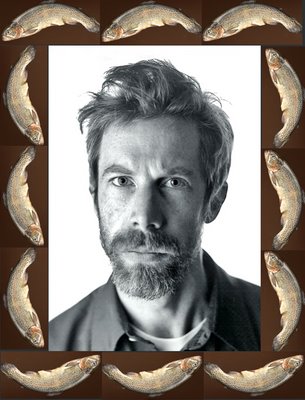
I had dinner at Rebbeca's last night and her mother Hilary told us how her husband (and Rebecca's father) Bruce had cooked the trout. Rebecca said it was very good and by the time her mother had arrived she and her father had eaten it all. I mentioned that the fish was a WTT. Rebecca asked me what that meant and I said it was a well traveled trout.
It all started last Thursday afternoon when the interim arts Straight arts editor Brian Lynch emailed me with the query to photograph actor Jonathon Young (and have results by that Monday). Jonathon Young plays the title role in this interesting Claudia Day play that is a Ruby Slippers production being staged at Performance Works beginning this Saturday at 8pm.
Young finally got back to me and he was going to show up at my Studio (last Saturday at one) which was his rehearsal lunch break. Meanwhile my Rosemary called around looking for a fresh trout that would fit my 8½ by 12 inch flat bed scanner. She found one on Granville Island. I paid $3.84 for it.
While Jonathon Young was himself when he came into my studio he was Trout Stanley (in the play he does not know why his parents gave him the name) he was in character when he faced my camera. There wasn't much for me to do except to click the shutter to the man I will discover this coming Saturday night. Lois Anderson is also in the cast. This pair has to be one of them most talented actors in town and Rosemay and I look forward to this play set in Tumbler Ridge. For me that is an added interest as I taught a weekend photography workshop for the Outreach Prgram of Emily Carr there and my students were already citing how the bottom was falling out in the coal mining town. Our provincial government had signed a contract to sell coal to Japan (for steel production)at a price that became well under the world price. The contract could not be modified so the town was on its way to go the way of Cassiar
After shooting Young (both Rebecca and Lauren were there as we had gone directly to the studio from Rebecca's jazz class at Arts Umbrella on Granville Island), Rebecca demanded to see the trout. At home I carefully unwrapped it and Rebecca picked it up and opened his/her mouth. She asked if it was a he? I told her I did not know. Several times on Saturday that trout paraded around the house in Rebecca's hands.
I scanned the trout and that evening at dinner, Rebecca placed the trout in front of her mother. I will never understand Rebecca's ability to pick up lizards, snakes, insects, spiders and now fish with an impunity that I find amazing.
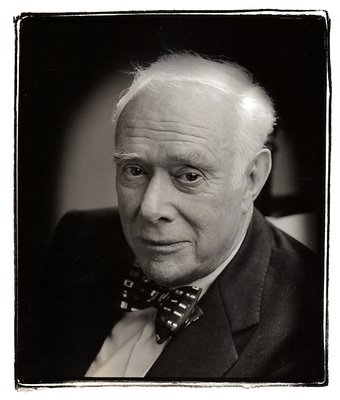
One chill Easter dawn in 1917, a blizzard blowing in their faces, the four divisions of the Canadian Corps in France went over the top of a muddy scarp knows as Vimy Ridge. Within hours, they held in their grasp what had eluded both British and French armies in over two years of fighting: they had seized the best-defended German bastion on the Western Front.
Even though I arrived with my wife and two daughters in 1975 I did not read a Canadian book until 1986. It was Pierre Berton's Vimy. My ignorance about Canada was appalling because I had mostly received an American based education in American schools in Argentina, Mexico and the US. World War I had not been won until the American Doughboys fought at Chateau-Thierry. And, of course, in WWII the Russians had not existed. John Hodiak had singlehandedly won it in William Wellman's 1950 Battleground.
So Pierre Berton's account of the Canadian involvement at Vimy Ridge that Easter of 1917 was shocking to me. It was then when I attempted to modify my American education. I have become proudly (almost fiercely ) Canadian and it was with lots of satisfaction that I was able to photograph my enlightener at the Meridien Hotel on October of 1984. I told Berton my story and with a warm smile on his face he said, "That should teach you."
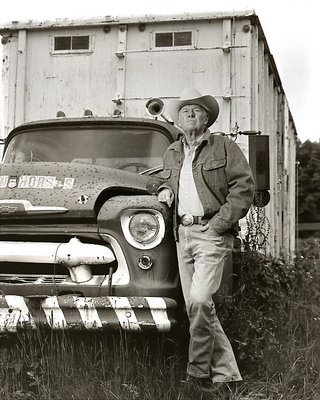
The 1987 Equity profile on BC Hyro's new boss, Chester Johnson had the above title as the lead to the story. The writer, Judy Lees had discovered that the urbane Johnson had a secret life as a rancher and loved horses. I was dispatched to find a location in Southlands that would serve as a backdrop for the photograph. When I found this old truck I was very happy. I then made an appointment with Mr. Johnson. The day of the shoot I was on the lookout for him. A beautiful maroon Maserati Quattroporte arrived and from it emerged Johnson, a most handsome man in one of the most beautiful suits I had ever seen. He asked me where the changing room was. I directed him to a nearby shack. In a few minutes the cowboy emerged. Through the years I got to photograph him again, particularly when he worked as head of the airport authority.
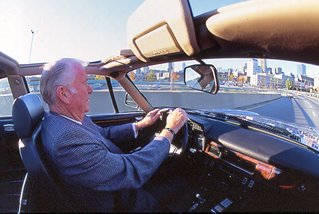
By then he had sold his Maserati and bought a Jaguar convertible. He took me for a spin and told me, "I do miss that Quattroporte on some days."
Today I wonder if any local executive would have Johnson's sense of humour or understand the power and value of a distinct image. Will the Chester Johnson and Jack Munro brand of executives ever come back? In the early 90s during the annual report boom I had some spare change and bought myself a maroon Maserati (alas the two-door version, the Biturbo, that was a poor cousin) and lived to regret my folly.
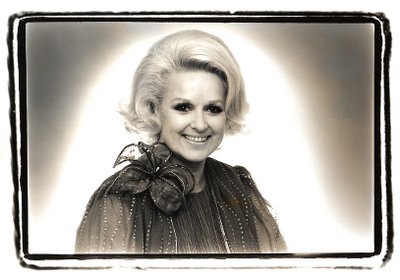
In February 1981 the singer Juliette was taping a variety show at the CBC in Vancouver. She interrupted the proceedings with a mighty, "Stop. Everything." There was quiet in the cavernous Studio 40. From the stage platform she shouted, "You, the photographer, down there. You are never to shoot me from the floor. I don't want my double chin to show!" I tried to sink further into the floor, but I did not succeed.
Sometime on a Sunday in 2000 I got off the Granville bus in front of the Commodore Ball Room. Even though it was early in the afternoon there was a lineup. At the end of the long line on my right, the guest list-line, there was a tall man in a red V-necked sweater. It was Jack Munro, former president of the International Woodworkers of America. In the shorter line on the left, for those with tickets, I spotted the immaculately dressed woman with a blond '60-era bouffant hairdo. It was Juliette.
I went up to her and asked her how it was that she was lined up for Dal Richards' afternoon tea dance series and nobody had whisked her in on a red carpet. If you consider that Juliette started her career at age 14., back in the 40s, as Dal Richard's "canary" with his big band on the Panorama Roof of the Hotel Vancouver, you should think she would be treated like royalty. "That's Vancouver for you. I just didn't want to miss today's show celebrating Mart Kennedy's 90th birthday," she explained. Mart Kennedy preceded Dal Richards with his Western Gentleman at the Hotel Vancouver in the 30s.
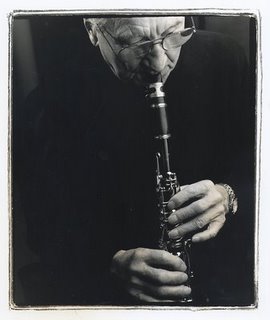
In a phone call to Dal Richards (right), he informed me that 100 Walk of Fame members were let into the Commodore simply by identifying themselves. Juliette chose to stand in line.
I asked Juliette if she had seen Munro in line. She peeked in his direction and said, "That communist."
In April 1984 I photographed Jack Munro in the offices of the now-defunct Vancouver business magazine, Equity, where I had set up a portable studio. Munro had been interviewed by Doug Collins for an article that stressed Munro's busy schedule and "many hats."
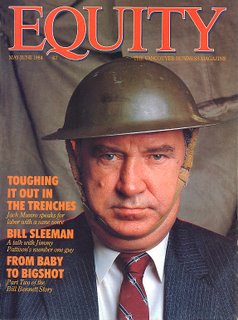
I was to photograph him with a hard hat, a ball cap, a top hat, a Chinese coolie hat and for the cover in a First World War helmet. With the helmet's chin strap firmly attached to the second part of his double chin, Munro looked rediculous. "Are you sure you want to do this?" I asked him. "I don't give a flying f---, just get it over with," he answered.
Before leaving Juliette, I reminded her of her direct involvement in that most embarrasing moment of my photographic career. With a smile she said, "I hope you have learned your lesson." She then added, "Vancouver's best photographer is that tall man from the Vancouver Sun. He stands up on a chair to photograph us women."As I left I told her, "I'll be sure to let Malcolm Parry know."
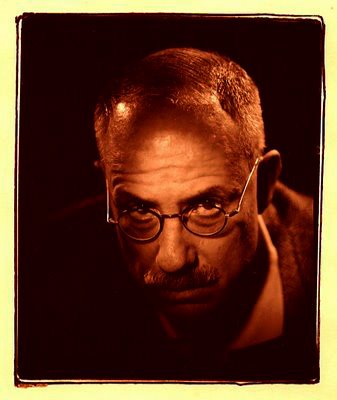
It was Tuesday, November 19, 1996, and I was waiting in the lobby of the Alexis Hotel in Seattle. A tall, wiry man with a buzz cut and a moustache, Harris tweed jacket, pullover, white shirt, and no tie came up to me and said, "Hi I am James Ellroy; call me Dog." "I'll call you Dog if you call me lad," I replied.
And that's how it was.
Note: My favourie Ellroy character, from the crime novelist's Los Angeles Quartet (LA Confidential is the better known volume), is Captain Dudley Smith, and he calls everybody lad.

Alas when I wrote this review for Duthie's Reader in 1995 how was I to know that Jerome Charyn would retire the "Pink Commish" Isaac Sidel and that I would have to satisfy my appetite for Charyn books with some not so satisfying books as a treatise on ping-pong (never table tennis) Sizzling Chops & Devilish Spins - Ping-Pong and the Art of Staying Alive (2001). Or I would polish off in an evening his slim autobiographical books like the one about his mother The Dark Lady From Belorusse (1997). Like most Chinese/Roumanian food these books left me hungry for more.
---------------------------------------------------------------
I'd lapsed into illiteracy after the High School of Music and Art. I could spell, yes...and think a little. I hadn't forgotten Modigliani. I'd pick up girls at the Metropolitan Museum of Art. I'd wander to the Frick Collection, stand in front of Rembrandt's Polish Rider, wait for that light, lovely sound of the Frick waterfall. I'd been a cartoonist once. I could draw every hair on King Kong's head and paint his blue nostrils. But I wanted to be Modigliani and elongate everything with hands, feet and faces were stretched out ike a choo-choo train. I was a counterfeiter. Modigliani manqué. - From Metropolis (1986)
By 1973, Bronx author Jerome Charyn, then thirty-six, had written seven novels. Each one had "sunk into invisibility". He decided to "scribble a crime novel". He invented a New York tribe of pork-eating marrano pickpockets, the Guzmanns (from Lisbon via Lima), angels of doom in the fall of Ping-Pong-playing NYPD homicide detective Manfred Coen in Blue Eyes.
Isaac Sidel, a character who haunts Blue Eyes, comes back in three more of
Charyn's crime novels, himself haunted by the dead Blue Eyes. Blue Eyes, Marilyn the Wild, The Education of Patrick Silver, and Secret Isaac are known as The Isaac Quartet. Beginning in 1990, Charyn wrote four more, The Good Policeman, Maria's Girls, Montezuma Man and Little Angel Street, collectively The Odessa Quartet. In the eight novels (all published my Mysterious Press) Isaac Sidel rises from first deputy police commissioner to commissioner(in which he uses a desk of that other famous commish, Teddy Roosevelt) and then in Little Angel Street to mayor elect of New York.
I was in Jerome Charyn's Greenwich Village apartment in October, 1995 and I asked him why Isaac Sidel always cried. Charyn replied, "In our culture it's considered effeminate. It condemns emotion in men. I like Isaac to be as if his whole body, everything about him, could express his feelings, from his tapeworm, to his sideburns, to his tears. He's someone who bleeds. His feelings erupt quickly. I like the idea of men crying."
While sipping my tea I watched Charyn's intense eyes and recalled a description of him by his friend Mexican writer Paco Ignacio Taibo II": the Vampire of Manhattan-Paris". (When Charyn is not in New York he lives in Paris in a flat overlooking Montparnasse cemetery.) I asked Charyn why he isn't rich and famous. In a resonant voice (Manfred Coen's, Isaac Sidel's?) he replied, "My use of language is very particular and it's something that many people cant'deal with. To me everything is in the language. Am I realy a crime writer? A mystery writer? When the French look at it they look at in in terms of the metaphysics. They understand what I am trying to do. I don't think the Americans really do. My books are linguistic attacks that happen to to talk about cops. I'm not intersted in catching the crook. They are a shadow land where good and evil just come together and you can't tell the difference."

Charyn describes his writing as "scratchy, secretive as a snake". Whatever it is, it a takes a bit fo trying to understand, but it will soon seduce you as it did me. Charyn's Isaac books are full of Roumanians(why Roumanians? "There are many in my apartment building"), odd characters with a fondness for frozen Milky Ways, people who get Glocked rather than killed, Zen descriptions of the advantages of Butterfly Ping-Pong bats (never paddles!) over sandpaper one, frequent diatribes on the loss of the New York Giants and baseball during World War II, of antiquarian baseball leauges, of Herman Melville, James Joyce, men that cry often, and the city of Carcasonne. Then there is Margaret Tolstoy, sometimes Anastasia, who wears wigs, carries a Glock, breaks Isaac's heart, and works for Frederick LeComte, the cultural commissa of the FBI, a villain in a blue suit. (Charyn named LeComte after a college professor who rejected his early attempts at writing.)

Between 1973 and 1994 Charyn wrote eleven other novels (including, in 1985, War Cries Over Avenue C a horrific book about Vietnam that Charyn describes as "a hallucination that hss the very fabric of New York") and a non-fiction book about New York Metropolis (my favourite book ever about the city), Darlin' Bill, a fantasy about "Will Bill" Hickok, won Charyn the Richard adn Hinda Rosenthal Foundation Award of the American Academny and Intitute of Arts and Letters in 1981. Asked about the award shortly afterterward, Charyn said, "It is given to 'that novel that is a commercial failure but is nevertheless a literary achievement'. You have to lose in order to win. In past years it's been won by Joyce Carol Oates, John Updike, Philip Roth, Thomas Pynchon and Bernard Malamud."
That Charyn isn't rich or famous I take as highly subjective but simple proof that God does not exist.
Note: In Charyn's last Isaac Sidel novel, Citizen Sidel (1999), the former commish becomes Vice President Elect of the United States. I am not sure if my favourite New York Times columnist, Maureen Dowd, has ever read Jerome Charyn. Her columns somehow remind me of Charyn's scribbles. All of Charyn's Isaac novels (and a couple non-Issac featuring retired hitman Sidney Holden, Elsinore and Paradise Man ) were designed and illustrated by the mysteriously named Bascove (above, left). While in New York in 1995 I did get to meet Bascove. Bascove was a very short and energetic young woman.
While I learned to perfect my ping-pong on the pitching deck of an Argentine Navy ship I had the impression that even with a Butterfly bat in my hand I would have been soundly defeated by Charyn.
Tarren's Sweet Spot At 50
Friday, April 13, 2007

There is a sweet spot where the bum of a woman suddenly becomes the thigh. I believe that it does not have a name. It should, because it is one of the most beautiful places on the human body.

And the most beautiful example of that most beautiful unnamed spot belongs to my friend Tarren. I have had the privilege to observe it in great detail in the almost 28 years that I have had the good fortune to take her photographs. Now Tarren's unamed spot is particularly beautiful because she happens to have one of the most beautiful bums and legs I have ever seen.

I will post here several photos to prove my point. She somehow posed a few times with furry friends both real and artificial. She even posed with my cat Gaticuchi in my home studio in Burnaby.

I have been prompted to post the photographs because today I am invited to celebrate Tarren's 50th birthday. I have been thinking about her as I sorted through my thick Tarren photo file. Have I been lucky?

Yes, specially as I have seen her mature and become a bit older than those 22 years she had when I first saw her. I will be a bit difficult for me to confirm tonight if her unamed spot is as good as ever. It is my suspicion that it is.
Much More Tarren
Kurt Vonnegut, W.G. Sebald & My Pentacon F
Thursday, April 12, 2007

Kurt Vonnegut 1922- 2007
Until 1964 I read every science fiction book I could find. I started this craze of mine around 1955 when I lost interest in reading about Achilles, the Greeks, the Trojans and the Spartans. That is how I first started reading Kurt Vonnegut. In 1952 he wrote Player Piano and in 1959 The Sirens of Titan. He was considered a science fiction writer much as Gore Vidal.
In 1958 I bought my first serious camera, a Pentacon F with a Jena made 50mm F-2.8 Tessar lens. On the bottom of the camera, embossed on the leather, it read "Made in USSR Occupied Zone.
The Pentacon traveled with me to Buenos Aires in 1965. In the first few months of my stint in the Argentine Navy I stayed with my mother's friends the American Sullivan family. The oldest son, John Sullivan was a conscript in the Argentine army. Since he had been educated in the US he was much older than the official age of 20. So John was 4 years older. At the time I felt I was an idealist and my world was black and white. John and I had massive arguments as he stated that the world was not cut and dry and that its colour was gray. He said that absolutes only existed in mathematics and science and in all other cases it was all relative.
In 1971, I had been married to Rosemary since 1968, she and I went to the American Mexican Institute of Cultural Relations ( a front for CIA) to listen to a lecture by Kurt Vonnegut. In his lecture (both Rosemary and I were charmed by his warm demeanor) he asserted that he had coined the term "open beaver". It was about then that I read Slaughterhouse Five and came to understand how right John Sullivan had been.
In Slaughterhouse Five I read how the Americans had sent bombers equipped with demolition bombs followed by British bombers with incendiary bombs. Some general had calculated how long it would take for neighbouring fire departments to send equipment into the fire bombed Dresden before unleashing another wave of bombers. I realized that my idea of good and evil, black and white was all wrong. John Sullivan had been right. The image of a raging lion escaping the Dresden zoo in the firestorm has been etched in my mind since. Vonnegut took care of eliminating that naivite of my youth.

Last year I read W. G. Sebald's horrific On the Natural History of Destruction and somehow it wasn't so horrific. Perhaps I had been deadened a bit by Vonnegut back in 1970. That Sebald, a German writer of note would die in an automobile accident in Norfolk, England in 2001 makes me suppose that Billy Pilgrim would have said, "and so it goes."
And yes that shattered Russian zone where the body of my Pentacon F was made was a quickly re-built Dresden.
The Uncommon Jake Kerr & Gathy Falk
Wednesday, April 11, 2007

For photographers in Vancouver the 80s were very good if you worked for the many business magazines that were around as I did. I made very good money. I don't feel too guilty as I really had to earn my money. For Weyerhaeuser I made several trips to Kamloops and walked miles looking for the "perfect" forest to photograph. For Wellwood Forest Products I braved minus 20 degree temperatures in Alberta to photograph mills at 2 a.m. Things got marginally better when I photographed the two
MacMillan Bloedel executives every year for many years. They were urbane, interesting and their office was here in Vancouver. I photographed many other forest product industry honchos and most of them were boring, very straight and the reading material in their reception offices (where I spent long hours waiting for them to give me the time of day) consisted of tractor brochures and infinitely boring forest industry trade magazines.
There was one exception and that was Lignum's Jake Kerr. His reception room at his office on West Georgia Street was decorated with Christopher Pratts. There were no forestry trade manuals but many interesting arts magazines and books. I could have easily waited for hours with such reading material.

In his office, the two times I visited Kerr, he had a pile of very red Gathy Falk (at right) apples sitting on a tall white plinth. I recall also seeing a Joe Fafard sculpture.
This does not mean that Kerr was completely the atypical BC forest product executive. I remember seeing him dressed in work boots and work clothes at the private jet terminal Esso Avitat in Vancouver. I was off to San Miguel de Allende for a magazine and Kerr was there surrounded by several men. When he said, "Let's go!" they all got up in unison and followed him out to the waiting jet. My guess is that Jake Kerr and all those others I photographed represent a end of an era.
Today I read in the Vancouver Sun an announcement that Jake Kerr has been appointed Chair of the Vancouver Foundation. If there is anybody who can promote and help the arts in Vancouver he has to be the man.
Rhododendron augustinii & The Kaponga Man
Tuesday, April 10, 2007

Yesterday morning when I looked through the window of my living room I saw masses of blue/lilac buds on a shrub that is dear to my heart. Perhaps ten years ago Kaponga (New Zealand) born plantsman (this is the term he prefers to describe himself) Alleyne Cook showed up in my garden with a pot that had a sorry stick emerging from it. "Alex you must have Rhododendron augustinii in your garden. Cook pronounces botanical names his own way and refuses to acknowledge the syllable that separates the two Is in the species name augustinii. We argued about it but then we both love to do that.
Rhodendron augustinii and Rhododendron racemosum are the first rhodos to bloom in my spring garden. This species rhodo is extremely popular as it is one of the few that approaches the colour blue. Strange as it may seem the island of Rhodes is named after the Greek word for rose or rhodon. Rhododendrons were perhaps given that name because of a similarity to the colour of roses. But both rhodos and roses share an inability to produce a pure blue flower.
Alleyne Cook told me, "Everybody thinks his or her augustinii is different so there are countless named cultivars." I tried to nail Cook down with some basic info on augustinii and he was most forthwith. It has all to do with the colour of the flower's throat. The perceived colour of this rhodo has a lot to do with it. If the throat is yellow or green the overall shift of the flowers will be from red to the blue spectrum while if the throat is maroon the shift will be towards the lilac. And then there are augustinii that are darker and others that are lighter.

Cook found a variety in his garden that was between two that were very dark and it had a yellow green throat. He named his plant Rhododendron augustinii 'Marion McDonnell' after his friend, Vancouver's "Blue Poppy Lady", Marion McDonnell. You can see him here proudly posing with her in his garden.
It is always a pleasure to visit or be visited by the Cooks. They are a perfect blend of charm with punctilious erudition.
Evelyn Lau In Bed
Monday, April 09, 2007

When the phone rang before 9 a.m. in the late 80s I was generally prepared for an urgent request for a photo of Vancouver writer Evelyn Lau to be sent pronto by Fedex (this was well before the press & send digital revolution). Those requests came from publishers and magazines in London, Tokyo, Copenhagen and once even from Sao Paulo.
Those lucrative awakenings began with an early-morning call from Toronto literary agent Denise Bukosky in December 1988. I was to photograph a 17 year-old girl, Evelyn Lau, for the cover of her book Runaway: Diary of a Street Kid. Based on a diary she started at 14, it details her experiences living on the street and her struggles with drugs, prostitution and attempted suicide. Nancy Flight, her editor, was to be my local contact.
When I met up with Flight in February 1989, outside Evelyn's rented suite, Flight's demeanour was glacial. Flight had called me a week before to ask for my studio address. I had replied, "I am going to photograph her where she lives. She will be more at ease. And I'll pose her on her bed. I's sure she has a young girl's beadspread." The silence on the line was eloquent. It didn't seem to help when I explained that I had a daughter of the same age and that I had photographed her on her bed. Flight stressed, "I'm going to be there."
Although the poised 17-year-old Lau seemed to be an adult (much more so than my daughter), she didn't think twice about my request. After all, she was also a teenager. I wasn't disappointed; her beadspread featured red balloons. Although another photo, not on the bed, taken later that day was ultimately used for the cover, I still treasure that first exposure of Evelyn on her bed with her dark-rimmed glasses.

She was to pose for me many times and here is one of my favourites as a mature woman (1990) who is most womanly and feminine.
Evelyn Lau, Elmore Leonard & John Lekich
Easter Sunday & The Purple Stain
Sunday, April 08, 2007

Rebecca and Lauren reversed roles with me yesterday at Granville Island. Rebecca had no ballet at Arts Umbrella and Lauren had a birthday party at Kids Only there, This meant that it was not Lauren but Rebecca with whom I had tea at the Granville Island Tea Company. Rebecca insisted we go to the Salmon Place to look at the trouts. It was here that I bought the trout for the picture of Jonathon Young as Trout Stanley. We also had a chat with carver artist Todd Woffinden and we asked him of the status of his partner Andrea Hodge. She is expecting in June. I believe that for Rebecca's birthday I may have to buy for her one of Todd's beautifully carved whale tales.
Yesterday was a pleasant sábado de gloria. I listened to Giordano's Andrea Chenier live from the Met (with no less than Ben Heppner in the title role) in CBC's Saturday Afternoon at the Opera.

At my request Rebecca coloured some Easter eggs and promptly dripped some purple dye on our living room's white sofa. I became a little furious. Once I got over with that we did the three scans you see here.
It is my Argentine nephew Georgito O'Reilly who says the most important activity of our existence is to converse and share food with our children, grandchildren and family. He is right.

Rosemary and I rounded out the day by enjoying a powerful, off the wall and really very funny Trout Stanley at Performance Works on Granville Island where I had begun my day. We both look forward to serving a meal to our family this afternoon.
Sábado De Gloria
Saturday, April 07, 2007

As I sat in the front pew of St Helen's Anglican Church with Abraham Jedediah Rogatnick yesterday evening I had thoughts of my grandmother Lolita and how she directed the Good Friday activities at home in Buenos Aires when I was a boy.
I had called Abraham in the morning to tell him that an unusual version of Mozart's Requiem was being Performed at St Helen's. The Vancouver Voices Quartet and Vancouver Chamber Players were performing the Requiem with only four voices and accompanied by a string quartet.
Many if not most of the patrons seemed to be parishioners of St Helen's (named after Constantine the Great's saintly mother). And there we were, a Catholic and a Jew sitting there discussing how three of the four singers had faulty Latin diction.
Perhaps my grandmother would have been shocked at it all or perhaps her anti-semitic stance was only Spanish 19th century upbringing. On Good Fridays I was not allowed to turn on the radio and sometime around 3 pm we would kneel on the living room floor in our Coghlan home and she would take us through the stations of the cross in Latin. I distinctly remember her telling me how the evil Jews had crucified Him. When describing people's faces she would sometimes say, "She has the map of Jerusalem on her face." Or she would switch to her alternate, "He is one of Jesus' countrymen."
But she never ever uttered a critical word about my best friend who lived across the street on Melián 2779. He was Mario Hertzberg. He, Miguelito (I have long forgotten his Calabarian surname) and I were inseperable and we were known as the inglesito (the english boy) el tano (the Italian) and el judío (the Jew).
Mario had two brothers but he once showed me the photograph of a third who looked much the same as he did except he was fatter and wore glasses. "That was my older brother but he died at a place called Auschwitz."
At age 8 I did not have enough curiousity to pursue the subject any further.
One day Mario and I went to see a Tarzan movie at the Saturday series sponsored by our local Capucine monks who were building a very large new church next door to the little community center and movie house. They charged us a token fee but we knew our money was going to a good cause. As we left after the show we were approached by a chubby Capucine who asked us our names. He asked me to what church I went to. When he questioned Mario, Mario replied, "I don't go to church I am a Jew." I will never forget the Capucine's smile as he placed his hand on Mario's arm and told us, "We share the same God and that is what is important." I thought about that for the rest of the day but I never confronted my grandmother with what to me was a clear difference of opinion.
I lost track of Mario Hertzberg when I was 20 but when I am with Abraham, even though he is 85, I find in his warm companionship, traces of that boyhood friendship that I miss but that somehow have come back.
It is appropriate that I write of this today. In Spanish, we call today Sábado de Gloria . It is an important day in Catholic liturgy as Catholics meditate on Easter Sunday. Easter Sunday is the most important feast day of them all. If the Man does not come back from the grave tomorrow it is all words and nothing more.
In my own little way I discovered last night as Abraham and I heard the lyrics:
tuba mirum spagens sonum (the trumpet will send its wondrous sound)
of a friendship reborn.
Michael Dibdin/Aurelio Zen - Requiescat in Pace
Friday, April 06, 2007

Michael John Dibdin, novelist, born March 21 1947; died March 30 2007.
I would have never known except for my tenacious information freak friend Mark Budgen who found out from a Guardian podcast. Budgen is one of those eccentric Englishmen who somehow jumped from LP records, bypassing the tape and CD era, straight into the iPod.
I met Michael Dibdin three times. The second time I traveled to Seattle to interview him for Celia Duthie's wondrous little gem, The Reader. He opened the door of his modest house while a woman next door eyed me while weeding, She was Dibdin's wife, ( his third and last), crime writer Kathrine Beck. They each wrote in their respective house but I didn't dare ask about their sleeping arrangement. Mark Budgen's contribution to my false, based in fear, diplomacy would have been, "Good for you, Alex." Budgen is an expert on living the life of two simultaneous households.
If I were to cite my favourite mystery book of all the ones I have ever read (I am having a hard time not considering our very own Canadian J. Robert Janes's excellent St-Cyr/Kohler mysteries) it would be Dibdin's definitive Venice based 1994 mystery novel Dead Lagoon. I will re-publish below my review that appeared that year in The Reader.
The Dead Lagoon
An Aurelio Zen Mystery by Michael Dibdin
Harper Collins Publisher Ltd, Toronto, 297 Pages, $25.00
Reviewed by Alex Waterhouse-Hayward
After finishing the Dead Lagoon , Aurelio Zen fans might think that Aurelio is in State Railways car compartment on his way home to Rome to his dotty mother Giustiniana. They might further think that he will try to patch up his eroding relationship with the fiery tempered Tania. They would we wrong - Aurelio Zen is actually living quietly in a modest house in the Wallingford neighbourhood of Seattle, with his friend Kathrine(crime writer K.K. Beck) and her extensive collection of Agatha Christie hardbacks. At least that's what I thought when Michael Dibdin opened the door on a morning in late February, 1995 puffing one of Aurelio's "camelshit Nazionali." Alas, I found out they were Marlboro Lights when we were sipping our strong expressos - not even Aurelio's usual caffé corretto with the added shot of grapa.
What had led me to that pleasant morning with Dibdin? ("His expression is stern, almost saturnine, yet his manner is courteous and respectful, " a description of Aurelio Zen in the Dead Lagoon fits Dibdin admirably,)in my search for Reginald Hill, Colin Dexter and Paco Ignacio Taibo II novels, my requests for new inspector Morses. Belascoarán Shynes and Dalziel and Pascoes at Duthie's, The Mystery Merchant Bookstore and Granville Books were frequently answered with a persistent, "No, but have you tried Dibdin's Aurelio Zen?"
Nine books later I am a fan. Michael Dibdin's ouput is divided into what he calls his "stand-alone novels", Dirty Tricks, The Last Sherlock Holmes Novel where Holmes, Moriarty and Jack the Ripper develop a very intimate relationship), The Tryst, A Rich Full Death, The Dying of the Lightand the four Aurelio Zen novels: Ratking, Vendetta, Cabal and Dead Lagoon. The hero is a Venetian-born plainclothes Vice-Questore of the elite Criminalpol squad of the Interior Ministry in Rome. He attempts to solve crimes in a world of police corruption and ineptness, a serpentine bureaucracy not all independent from the mafiosi. In Dead Lagoon Aurelio returns to his origins, a wintry Venice, to seek a solution to the kidnapping and disappearance of wealthy American industrialist. Not since Ian McEwan's The Comfort of Strangers have I read such a vivid description of Venice. But this is a bleak Venice powdered by snow, enveloped by fog and with an ever diminishing population, A shadowy Venice that turns into a ghost town in the evenings. Aurelio Zen has almost forgotten his roots as Dibdin describes:
When he awoke again the room was filled with an astringent brilliance which made him blink, an abrasive slapping of wavelets andthe edgy scent which had surprised him the moment he stepped out of the train. He had forgotten even the most obvious things about the place, like the pervasive risky odour of the sea.
Little is known of Aurelio's off hour tastes and diversions, and Dibdin the writer will rarely volunteer much personal information, he does not much approve of policemen like PD James'Inspector Dalgliesh moonlighting as a published poet. Dibdin likes to keep bothhis and Aurelio's life private. But I was able to extract a bit about both, I asked about Aurelio's views on grappa; Dibdin's answer: "Like all Italians, he would regard any commercial grappa as second-rate by definition. The only good stuff comes from some private connection with a winemaker who distills their own. But I think he would not despise Nardini's Reserva (as he would Grappa Giulia) which is the most commonly available brand), and in a pinch he would drink anything."
Dibdin has lived outside his native England more than he has in. At various stages of his life he has resided in Ireland, Scotland, Italy (he taught English in Perugia for four years) and has spent five years in Canada, Edmonton and Vancouver. Dibdin, born in 1947, might just have been another hippie who haunted Kitsilano in the late 60s, not by his direct admission, but I quote: "I lived in many houses -we moved every month or so, it seems now - mostly in Kitsilano. I wrote a whole novel while there. It has never been published. But it was a very important period of my life, and opened my eyes to the possibilities of life in ways I have subsequently exploited in the published books. I also taught a course in philosophy for Vancouver Free University, made money writing essays for students at UBC and Simon Simon Fraser and was an avid reader of the Georgia Straight. It was my second adolescence - much better than my first!"
Although Dibdin does not share Jonathan Raban's love for Schubert and prefers Mozart, he does dine once a month with that other British expatriate and Seattle resident. "We swap anecdotes and theories about Seattle and the Northwest, about which we disagree; Kathrine is fourth-generation Seattle and gives me a very different take on the place from Raban's 'city of immgigrants.'"
While in Seattle Dibdin has written one of his stan-alone novels Dark Spectre , a police procedural set in Seattle - to be published in England in June and in Canada next January. The big news for Aurelio Zen fans is that Dibdin has sold three of the Zen books to the BBC. Julian Mitchell, who wrote the successful screenplays for the Inspector Morse series, is working on Dead Lagoon and if all goes well Aurelio Zen will hit our screens by summer of 1996.
For those who can't wait until the next Aurelio Zen - "It will be set in Naples, with an opera buffa quality(I hope!)" - there are two options. One is to try Aurelio's recipe on page 132 of Dead Lagoon for spaghetti Aglio, olio e peperoncino on a potential loved one and immediately raise the temperature of your relationship. (Dibdin stresses that no cheese is used for Aurelio's recipe.) The other is to look for Dibdin's only published short story. GQ commissioned him to write a story based on his experiences during a trip to Argentina. A Death in the Family involves Jorge Luis Borges, a fiendish young girl, and the disappeared of Argentina's dirty war. Although it has been widely translated in Europe and in the East, Ellery Queen Magazinefound it too depressing to publish it in the US. Where can this story be found? "The short story was in GQ in 1990. August, I think. It is also in the anthology Best Short Stories of 1991 Heinemann, London 1991."
Having established a connection between this Argentine reviewer's fondness for Borges and Dibdin's only published short story I decided to enquire about my favourite Mexican crime writer Paco Ignacio Taibo II. Surprise! "Kathrine and I met in Gijón, Spain, where we were both attending a mystery writers' conference , Semana Negra organized by Paco Taibo. And please don't call her my companion in crime."
Alex Waterhouse-Hayward, having run out of Colin Dexter, Reginald Hill, Paco Ignacio Taibo II and Michael Dibdin is currently reading the crime novels of that eminent Newyorican, Jerome Charyn.
Michael Dibdin and a Venetian gondola
Trout Stanley, Jonathon Young & The Well Traveled Trout
Thursday, April 05, 2007

I had dinner at Rebbeca's last night and her mother Hilary told us how her husband (and Rebecca's father) Bruce had cooked the trout. Rebecca said it was very good and by the time her mother had arrived she and her father had eaten it all. I mentioned that the fish was a WTT. Rebecca asked me what that meant and I said it was a well traveled trout.
It all started last Thursday afternoon when the interim arts Straight arts editor Brian Lynch emailed me with the query to photograph actor Jonathon Young (and have results by that Monday). Jonathon Young plays the title role in this interesting Claudia Day play that is a Ruby Slippers production being staged at Performance Works beginning this Saturday at 8pm.
Young finally got back to me and he was going to show up at my Studio (last Saturday at one) which was his rehearsal lunch break. Meanwhile my Rosemary called around looking for a fresh trout that would fit my 8½ by 12 inch flat bed scanner. She found one on Granville Island. I paid $3.84 for it.
While Jonathon Young was himself when he came into my studio he was Trout Stanley (in the play he does not know why his parents gave him the name) he was in character when he faced my camera. There wasn't much for me to do except to click the shutter to the man I will discover this coming Saturday night. Lois Anderson is also in the cast. This pair has to be one of them most talented actors in town and Rosemay and I look forward to this play set in Tumbler Ridge. For me that is an added interest as I taught a weekend photography workshop for the Outreach Prgram of Emily Carr there and my students were already citing how the bottom was falling out in the coal mining town. Our provincial government had signed a contract to sell coal to Japan (for steel production)at a price that became well under the world price. The contract could not be modified so the town was on its way to go the way of Cassiar
After shooting Young (both Rebecca and Lauren were there as we had gone directly to the studio from Rebecca's jazz class at Arts Umbrella on Granville Island), Rebecca demanded to see the trout. At home I carefully unwrapped it and Rebecca picked it up and opened his/her mouth. She asked if it was a he? I told her I did not know. Several times on Saturday that trout paraded around the house in Rebecca's hands.
I scanned the trout and that evening at dinner, Rebecca placed the trout in front of her mother. I will never understand Rebecca's ability to pick up lizards, snakes, insects, spiders and now fish with an impunity that I find amazing.
Vimy, Pierre Berton & The Re-Education of An "American"
Wednesday, April 04, 2007

One chill Easter dawn in 1917, a blizzard blowing in their faces, the four divisions of the Canadian Corps in France went over the top of a muddy scarp knows as Vimy Ridge. Within hours, they held in their grasp what had eluded both British and French armies in over two years of fighting: they had seized the best-defended German bastion on the Western Front.
Even though I arrived with my wife and two daughters in 1975 I did not read a Canadian book until 1986. It was Pierre Berton's Vimy. My ignorance about Canada was appalling because I had mostly received an American based education in American schools in Argentina, Mexico and the US. World War I had not been won until the American Doughboys fought at Chateau-Thierry. And, of course, in WWII the Russians had not existed. John Hodiak had singlehandedly won it in William Wellman's 1950 Battleground.
So Pierre Berton's account of the Canadian involvement at Vimy Ridge that Easter of 1917 was shocking to me. It was then when I attempted to modify my American education. I have become proudly (almost fiercely ) Canadian and it was with lots of satisfaction that I was able to photograph my enlightener at the Meridien Hotel on October of 1984. I told Berton my story and with a warm smile on his face he said, "That should teach you."
Chester Johnson Is A Cowboy
Tuesday, April 03, 2007

The 1987 Equity profile on BC Hyro's new boss, Chester Johnson had the above title as the lead to the story. The writer, Judy Lees had discovered that the urbane Johnson had a secret life as a rancher and loved horses. I was dispatched to find a location in Southlands that would serve as a backdrop for the photograph. When I found this old truck I was very happy. I then made an appointment with Mr. Johnson. The day of the shoot I was on the lookout for him. A beautiful maroon Maserati Quattroporte arrived and from it emerged Johnson, a most handsome man in one of the most beautiful suits I had ever seen. He asked me where the changing room was. I directed him to a nearby shack. In a few minutes the cowboy emerged. Through the years I got to photograph him again, particularly when he worked as head of the airport authority.

By then he had sold his Maserati and bought a Jaguar convertible. He took me for a spin and told me, "I do miss that Quattroporte on some days."
Today I wonder if any local executive would have Johnson's sense of humour or understand the power and value of a distinct image. Will the Chester Johnson and Jack Munro brand of executives ever come back? In the early 90s during the annual report boom I had some spare change and bought myself a maroon Maserati (alas the two-door version, the Biturbo, that was a poor cousin) and lived to regret my folly.
Juliette, Dal Richards, Jack Munro & Double Chins
Monday, April 02, 2007

In February 1981 the singer Juliette was taping a variety show at the CBC in Vancouver. She interrupted the proceedings with a mighty, "Stop. Everything." There was quiet in the cavernous Studio 40. From the stage platform she shouted, "You, the photographer, down there. You are never to shoot me from the floor. I don't want my double chin to show!" I tried to sink further into the floor, but I did not succeed.
Sometime on a Sunday in 2000 I got off the Granville bus in front of the Commodore Ball Room. Even though it was early in the afternoon there was a lineup. At the end of the long line on my right, the guest list-line, there was a tall man in a red V-necked sweater. It was Jack Munro, former president of the International Woodworkers of America. In the shorter line on the left, for those with tickets, I spotted the immaculately dressed woman with a blond '60-era bouffant hairdo. It was Juliette.
I went up to her and asked her how it was that she was lined up for Dal Richards' afternoon tea dance series and nobody had whisked her in on a red carpet. If you consider that Juliette started her career at age 14., back in the 40s, as Dal Richard's "canary" with his big band on the Panorama Roof of the Hotel Vancouver, you should think she would be treated like royalty. "That's Vancouver for you. I just didn't want to miss today's show celebrating Mart Kennedy's 90th birthday," she explained. Mart Kennedy preceded Dal Richards with his Western Gentleman at the Hotel Vancouver in the 30s.

In a phone call to Dal Richards (right), he informed me that 100 Walk of Fame members were let into the Commodore simply by identifying themselves. Juliette chose to stand in line.
I asked Juliette if she had seen Munro in line. She peeked in his direction and said, "That communist."
In April 1984 I photographed Jack Munro in the offices of the now-defunct Vancouver business magazine, Equity, where I had set up a portable studio. Munro had been interviewed by Doug Collins for an article that stressed Munro's busy schedule and "many hats."

I was to photograph him with a hard hat, a ball cap, a top hat, a Chinese coolie hat and for the cover in a First World War helmet. With the helmet's chin strap firmly attached to the second part of his double chin, Munro looked rediculous. "Are you sure you want to do this?" I asked him. "I don't give a flying f---, just get it over with," he answered.
Before leaving Juliette, I reminded her of her direct involvement in that most embarrasing moment of my photographic career. With a smile she said, "I hope you have learned your lesson." She then added, "Vancouver's best photographer is that tall man from the Vancouver Sun. He stands up on a chair to photograph us women."As I left I told her, "I'll be sure to let Malcolm Parry know."
James Ellroy
Sunday, April 01, 2007

It was Tuesday, November 19, 1996, and I was waiting in the lobby of the Alexis Hotel in Seattle. A tall, wiry man with a buzz cut and a moustache, Harris tweed jacket, pullover, white shirt, and no tie came up to me and said, "Hi I am James Ellroy; call me Dog." "I'll call you Dog if you call me lad," I replied.
And that's how it was.
Note: My favourie Ellroy character, from the crime novelist's Los Angeles Quartet (LA Confidential is the better known volume), is Captain Dudley Smith, and he calls everybody lad.






